How To Make A Cover Page For An Assignment? An Ultimate Guide
Link Copied
Share on Facebook
Share on Twitter
Share on LinkedIn

Level Up Your Assignment Game!
What if you made a shiny assignment but forgot to make the cover page? Remember that first impression in 'The Devil Wears Prada'? Well, your cover page deserves a standing ovation, not a silent groan from your teacher. But don't worry! Here's an ultimate guide on how to make a cover page for an assignment that will transform your cover page from 'blah' to 'wow' in no time!

What is a Cover Page in an Assignment?
The cover page, your essay's first impression, sets the stage for professionalism. It's where your name, course details, and due date greet your instructor. Though not always obligatory, its polished presentation can earn you favour. Following a good format often leads to higher scores, making it a smart academic move.
Why is a Cover Page Important?
As students, we all know the adage - you never get a second chance to make a first impression. That's where the cover page comes in - it's the gatekeeper to your assignment, and trust us, you don't want to drop the ball here. Mess it up, and your professor might write you off before they even start reading. But nail it? Well, that's like hitting a home run before you've even stepped up to the plate.
If you are thinking about how to make a cover page for an assignment, a well-formatted, error-free cover page is the key to unlocking your instructor's curiosity. Following the institution's template is just the cherry on top, showing you're a team player who respects the rules of the game.
How to Make a Cover Page for an Assignment?
When it comes to assignments, the cover page is our chance to grab the professor's attention right off the bat. Why settle for a drab intro when you can learn all about how to design the front page of an assignment? Let's dive into the essential elements of the cover page.
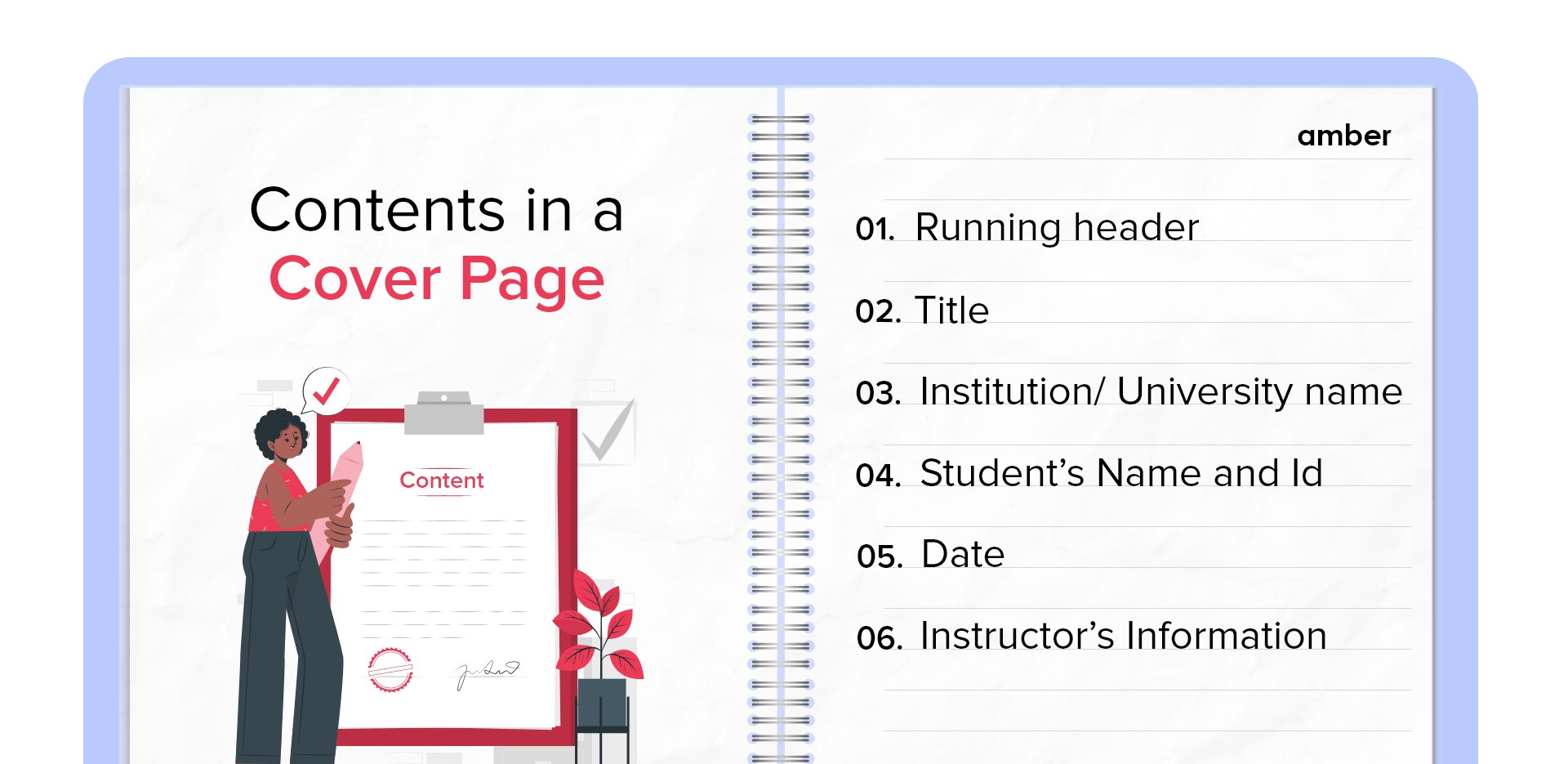
1. Running Header
A running header goes on top of cover pages, separate from the main text. It's often used for APA style. Keep it short, 50 characters max, all uppercase.
Next is the title, explaining your work's content. Write it in the title case, capitalising most words. Avoid abbreviations and aim for 15-20 words. Centre the fully written title on the cover page.
3. Institution/ University Name
Your university or institution name belongs on the cover page, too. Different from the title, it shows readers where you're from and did the research. For reports or presentations, include your workplace or school.
4. Student’s Name and ID
Clearly state the author(s) name(s) and id(s) on the cover page. Include affiliations for multiple authors. For group projects, list all students' names and universities before the title. This ensures proper author credit.
Including the date on your cover page tells readers when you finished the work. Use the exact publication date. This also helps for future reference if someone needs to find work within a certain timeframe.
6. Instructor’s Information
Providing your instructor's details, such as name, designation, and department, shows you completed the work for their specific class. It ensures the assignment reaches the right person and department, avoiding any confusion.
Make your assignment's cover page in peace with amber's comfortable housing!
Book through amber today!
How to Make A Front Page of an Assignment: APA Format
The APA (American Psychological Association) format heavily emphasises the cover page details. To know how to make a cover page for an assignment in an APA format, follow these specific guidelines.
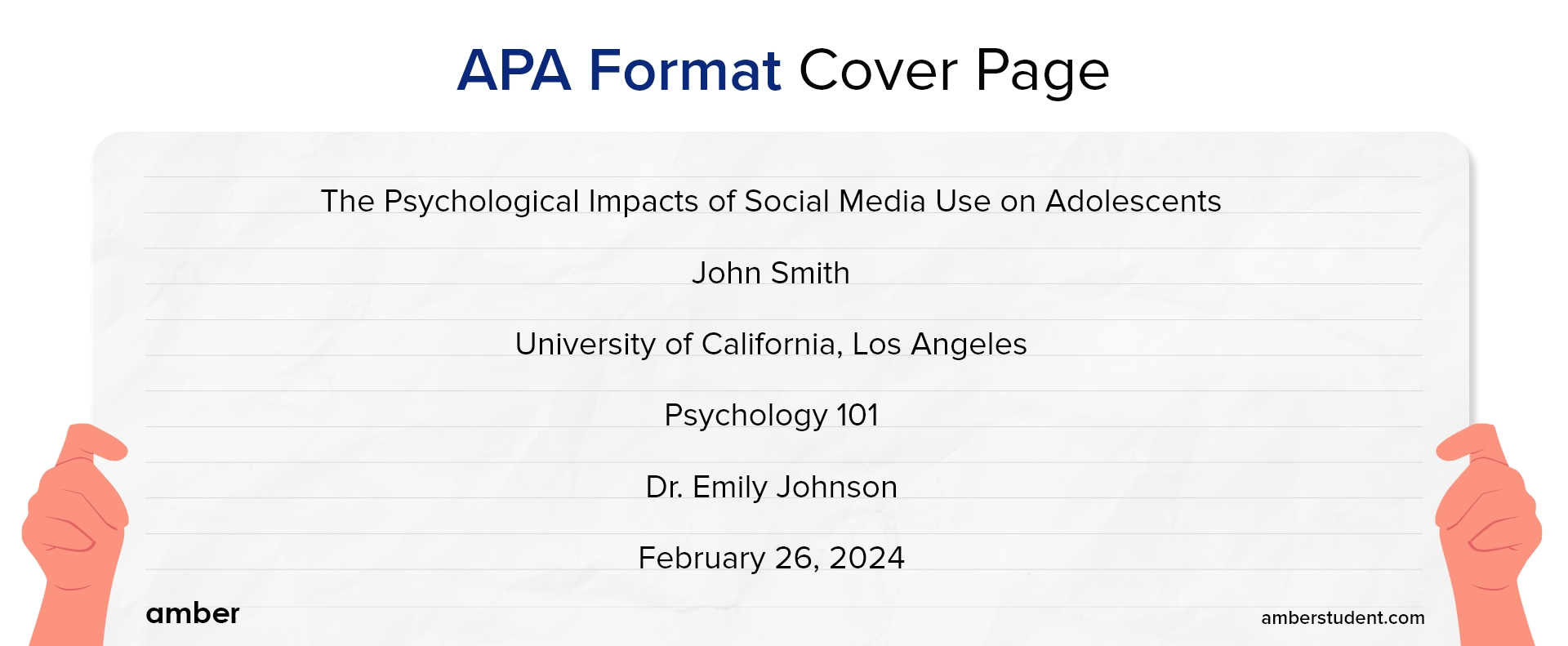
1. Page Number Placement: Start by placing the page number in the upper-right corner, always as 1, aligning it with the one-inch margin. This will be part of your running head, a feature in APA format, but for student papers, it's just the page number.
2. Title Placement: Move down three or four lines (double-spaced) from the top and centre of your paper's title. Make it bold and use proper capitalization rules for titles.
3. Author's Name: After the title, leave an empty line, then write your name. Keep it simple without any special formatting. If there are multiple authors, separate their names with commas and use "and" before the last author's name.
4. Department and School: Below your name, write your department or division, followed by your school's name, separated by a comma.
5. Course Information: Directly below your school's name, include the course name along with its numeric code.
6. Instructor's Name: Under the course information, write your instructor's full name, including any titles like 'Dr.'
7. Date: Finally, on the last line, write the date. Spell out the month for clarity.
How to Create a Cover Page for an Assignment: MLA Format
In MLA (Modern Language Association) style, you usually don't need a cover page; instead, you list essential details at the start of the first page. If you are wondering how to make an assignment front page in MLA style, here are the instructions.
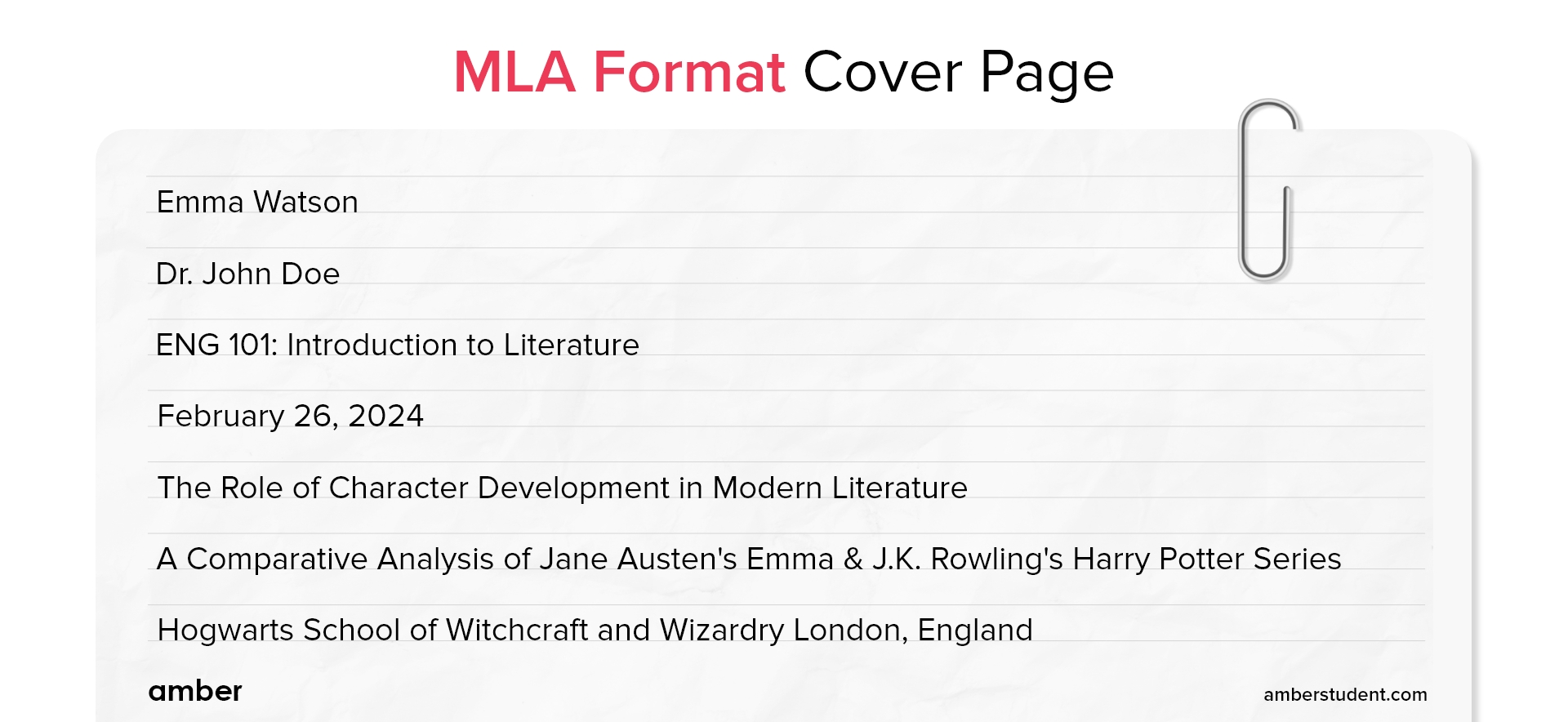
1. Student’s Name: Begin with the first student’s name on the top-left corner of the page, double-spaced.
2. Additional Authors: If there are more authors, list each on a separate line following the first student’s name.
3. Instructor’s Name: Below the last author’s name, including the instructor’s title, like “Professor Willow,” on a new line.
4. Course Details: Write the course name along with its numeric code on the next line.
5. Date : Following the course details, write the date in full, avoiding abbreviations for months. You can use either day-month-year or month-day-year format.
6. Title of the Paper : Centre the title four or five lines below the date, maintaining double spacing. Remember to capitalise the title according to standard rules, avoiding bold or italics.
How to Design Cover Page for Assignment: CMS Format
CMS (Chicago Manual of Style), a citation method for acknowledging sources in academic papers, grants ownership rights to authors, preventing plagiarism and aiding readers in locating sources. However, mastering one style isn't sufficient due to varying rules.
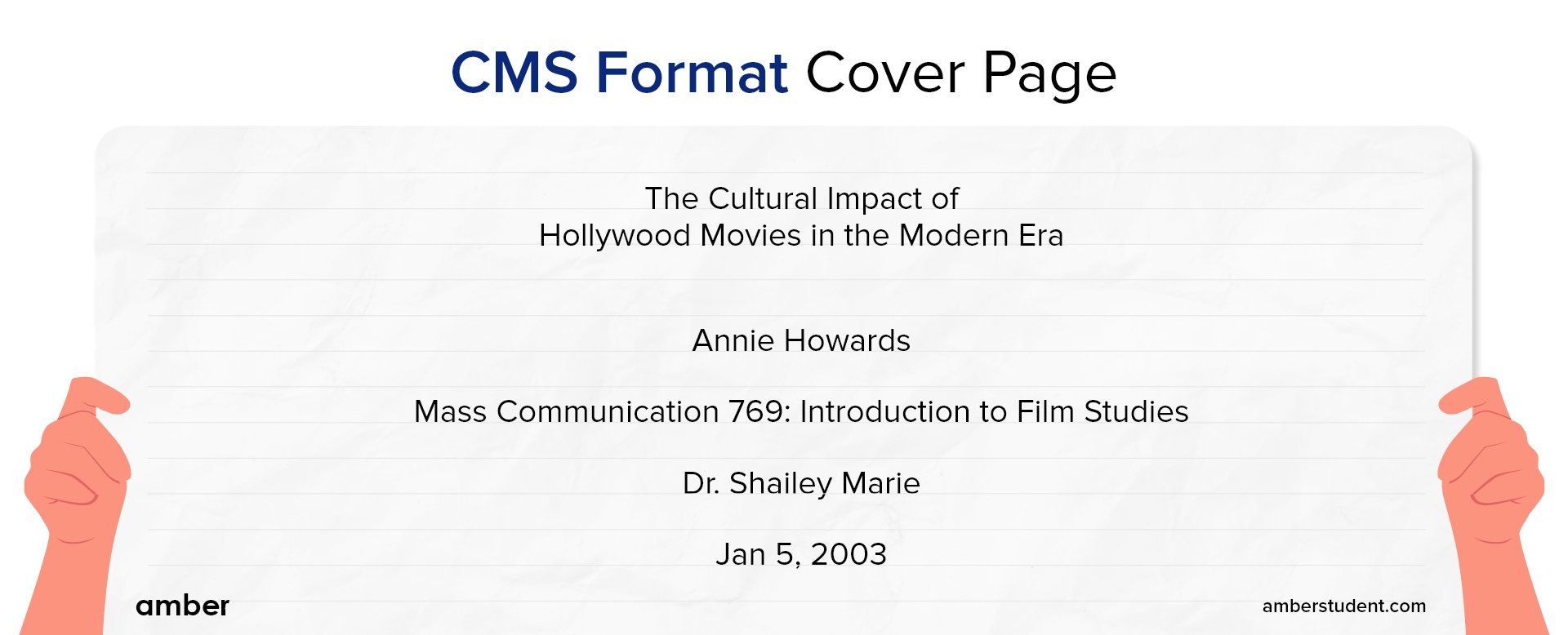
1. Margins: Leave one-inch margins on all sides of your cover page to give it a neat look and provide space for your text.
2. Font: Stick to Times or Times New Roman font in 12 pt size for a professional appearance that's easy to read.
3. Spacing: Double-space the text on your cover page to make it clear and readable.
4. Text Alignment: Align your text to the left to create a clean, organised appearance, avoiding fully justified text.
5. Indentation: Start paragraphs, block quotes, and bibliography entries with a 1/2" indent for a structured layout.
6. Page Numbers: Number your pages in the top right corner, excluding the cover page. Include your last name to avoid confusion if pages get mixed up.
7. Two-Sided Printing: Confirm with your teacher if you can print on both sides of the paper for eco-friendly printing.
8. Title: Centre the title of your paper halfway down the page for prominence and clarity.
9. Name: Centre your name under the title to identify yourself as the author.
10. Teacher's Information: Write your teacher's name, course title, and date at the bottom, centred in three lines.
11. Font Consistency: Maintain consistency by using Times or Times New Roman font in 12 pt size for the cover page. Avoid using bold, underline, or decorative fonts.
12. Page Numbering and Count: Exclude the cover page from page numbering and total page count. It's not necessary to add a page number to the cover page.
Tips and Tricks to How to Make a Good Cover Page for an Assignment?
Now that you have understood how to make a cover page for an assignment, it is also necessary to understand the basic tips and tricks before you start writing one. To make a great cover page, follow the steps outlined in the guide.
1. Correct Information
The main tip for knowing how to design a cover page for an assignment is to ensure that the cover page includes accurate details such as your name, assignment title, course name, date, and any other required information to avoid confusion and errors.
2. Formatting
Use consistent formatting throughout the cover page, including font style, size, and spacing, to present a polished and organised appearance that aligns with academic standards.
3. Relevance
If you’re wondering how to write thea front page of an assignment, then include relevant details that provide context. This would help the reader understand the purpose and scope of your work.
4. Clarity and Conciseness
Keep the content of the cover page clear and concise, using simple language and avoiding unnecessary information to communicate your message effectively.
5. Professional Tone
Maintain a professional tone on the cover page by using formal language and addressing the recipient respectfully, reflecting your commitment to the assignment and your academic integrity.
6. Proofreading
Carefully proofread the cover page for any grammatical errors, typos, or inconsistencies to ensure it reflects your attention to detail and presents a polished final product.
A well-crafted cover page can make your assignment shine like a diamond in the rough. Follow these tips for how to write the front page of an assignment, and you'll impress your professor right off the bat. Don't drop the ball on this crucial first impression; knock their socks off with an A+ cover page material!
Frequently Asked Questions
Do cover pages for an assignment have pictures, what is the difference between a cover letter and a cover page for an assignment, how long should a cover letter for an assignment be, is a 2-page cover letter for an assignment too much, what is the difference between the front page and the cover page.
Your ideal student home & a flight ticket awaits
Follow us on :

Related Posts

Felix Scholarship: Eligibility, Application Process & More
.jpg)
Top 10 Most Expensive Universities In The World 2024-25

A Simple Guide To Percentage To GPA Conversion

Planning to Study Abroad ?

Your ideal student accommodation is a few steps away! Please fill in your details below so we can find you a new home!
We have got your response

amber © 2024. All rights reserved.
4.8/5 on Trustpilot
Rated as "Excellent" • 4800+ Reviews by students
Rated as "Excellent" • 4800+ Reviews by Students
We use cookies to ensure we give you the best experience of our website. By browsing this site you accept we use cookies to improve and personalise our services and marketing. Read our privacy statement for more about what we do with your data, as well as your rights and choices.
- Studying by distance learning
- Get prepared for study
- How much time will you need?
- International and studying from overseas
- About our qualifications
- How to decide what to study
- Full-time or part-time study?
- How we'll support your studies
- Online tools and resources
- Te tautoko i te angitū o ngā ākonga Māori - Supporting Māori learner success
- Pasifika learner support
- Disability and Access Services
- Access to local campus services
- Fees free study
- Paying your fees
- Student loans
- Scholarships, awards and financial assistance
- Learner stories
- Choose courses
- How to apply to enrol
- Enrolment dates
- Recognising previous study and experience
- English language entry requirements
- Providing proof of your identity
- Terms and conditions of enrolment
- Fees and funding
- Changes to your enrolment
- Changes to benefit Open Polytechnic learners
- Student Advisory Group
- Disclaimer and copyright statement
- Notice of meetings
- Jobs at Open Polytechnic
- Who are our learners?
- Our Māori learners
- Our Pasifika learners
- Media Contact
- Publications
- First Impressions Survey
- Academic research
- Hei whaiwhakaaro i mua i tō ako - Some things to think about before you study
- Te whakatau he aha hei ako māu - Deciding what to study
- Whakawhiwhinga ākonga Māori - Scholarships and awards for ākonga Māori
- Message from Pule Ma’ata - Pasifika
- Meet our kaimahi Pasifika
- Pasifika success
- Scholarships for Pasifika
- Getting started with online learning
- Course and study support
- Supporting Māori learner success
- Dyslexia and the Dyslexia-Friendly Quality Mark
- Meet some of our learners
- Get help with academic writing and research skills
- Mental health support
- Using iQualify
- MyOP learner portal and app download
- Accessing your learner email and free Microsoft software
- Our library
- Assistive technology tools
- Helperbird free assistive technology tool
- How to re-enrol
- Withdrawals and course transfers
- Learner forms
- Get your student ID card
- Get started
- Make a plan
- Set study goals
- Reading skills
- Active learning
- Taking notes
- Mind mapping
- Researching
- Evaluating information
- Critical thinking for reading and research
- Step-by-step guide to tackling assessments
- Assessment types
- Plan your assessment
- Understand your assessment task
- Writing skills
Formatting and presenting assessments
- Assessments information
- Referencing and plagiarism
- How to reference
- Preparing for exams
- Types of exam questions
- Planning your time for an exam
- Information for sitting exams
- Research ethics for doing research projects
- How your work will be assessed
- How to submit your assessment for marking
- Submitting your work in te reo Māori
- How to request an assessment extension
- Special Consideration for in-course assessments
- Grading scales
- Academic Integrity
- Assessment writing
- Referencing
- Word limits and word count guidelines
- Using AI - Artificial Intelligence services
- Exam dates and venue information
- Exam admittance information and permitted materials
- Information for exam day
- Sitting exams from overseas
- Getting assistance with exams
- Exam reconsiderations, resits and the return of exam papers
- Aegrotat consideration
- Getting your final results
- Te whare tapa whā
- The Fonofale model of health
- Taha tinana – physical wellbeing
- Taha hinengaro – mental wellbeing
- Taha whānau – family, community and social wellbeing
- Taha wairua – spiritual wellbeing
- Free mental health support
- Rainbow learner support
- Applying to graduate
- Attending a graduation ceremony
- Academic transcripts
- Graduation Live Stream
- Tertiary and International Learners Code of Practice
- Complaints and concerns
- Learning Engine LMS
- CPD and training services
- Digital design, video, animation and software development
- Instructional design
- Content licensing
- Digital design, video and animation
Formatting and presenting your assessments correctly is important because many include marks for presentation.
This may include marks for things such as:
- formatting and layout
- APA referencing
- writing style
- grammar and spelling.
Before you start on your assessment:
- check your assessment question, emails from your course leader, and learning materials for how it should be presented
- read the instructions carefully. Make sure you understand them and follow them exactly
- if you're not sure about what’s required contact your course leader.
General guidelines for electronic submissions
- Most assessments should be produced using Microsoft Word.
- You can also submit assessments using: .doc, .docx, .xls, .xlsx or .rtf.
- if you don’t have Microsoft Word go to My Open Polytechnic to download and access your free version
- if you're not sure about the file type required, contact your course leader.
- Use a clear, readable font, such as Verdana, Calibri, Tahoma or Arial and use the same font throughout.
- Use black text on a white background.
- Avoid coloured backgrounds or text in a colour other than black, unless you have special permission to use them.
- Use 11 or 12 point font for the body of your assessment.
- Use 1.5 spacing and 2.53 cm (1”) wide margins.
- Leave a blank line between paragraphs.
- If the questions are short, leave a blank line between each question. If they are long, start each question on a new page.
- Left-justify your work (also known as left-aligned).
- Use bold for headings.
- Essays don’t usually need subheadings; reports usually do.
Most assessments need a title page, which should include:
- the title and number of the assessment
- the course number and name
- the due date
- your full name and student number.
Centre this information on the page, starting approximately one-third of the way down the page.
- Number and clearly label figures and tables.
- Add numbers as follows: Figure 1, Figure 2, Table 1, Table 2, and so on.
- Put table and figure captions above the table.
- Don't number the items in a reference list.
For more help with figures and tables, check:
Get more help with tables and figures – APA Style website
Headers and footers
Insert a header or footer on each page (except the title page). It should contain:
- your name (last name, first name/s)
- your student number
- the course code
- the assessment number
- page numbers.
Reference list
The reference list comes at the end of the assessment and should start on a new page labelled 'References'.
Need more help with reference lists? Check out the guides below:
Quick referencing APA guidelines (PDF 47 KB; opens in a new window)
Guide to APA referencing (PDF 395.11 KB; opens in a new window)
Appendices are used for information that:
- is too long to include in the body of your assessment
- supplements or complements the information you are providing.
Start each appendix (if applicable) on a new page. If there's just one appendix label it ‘Appendix’ without a number. If there is more than one, label them Appendix A, Appendix B, and so on.
In the main text of your assessment, refer to the Appendix by the label – for example, Appendix A.
Tops and bottoms of pages
Check the top and bottom of your pages to ensure they avoid:
- widows – single lines of text at the top of a page
- orphans – first lines of paragraphs at the bottom of a page
- tombstones – headings or subheadings alone at the bottom of a page
- split lists – lists that are divided between two pages (if possible).
General guidelines for hard copies
Most of the guidelines above also apply to hard copies (printed or handwritten documents).
If your course requires or allows handwritten assessments, be sure to follow the course instructions on presenting handwritten assessments.
Word limits and word count guidelines
Word limits support the development of concise writing skills. Word count guidelines help you to understand the expectation of workload for an assessment.
For more detailed information about these go to:
Word limits and word count guidelines
Got a question?
If you want to talk with someone about formatting and presenting your assessments, contact The Library and Learning Centre | Te Whare Pukapuka Wāhanga Whakapakari Ako.
Contact the Library and Learning Centre

Free Cover Page templates
Create impressive cover pages for your assignments and projects online in just a click. choose from hundreds of free templates and customize them with edit.org..
Create impressive cover pages in a few minutes with Edit.org, and give your projects and assignments a professional and unique touch. A well-designed title page or project front page can positively impact your professor's opinion of your homework, which can improve your final grade!

Create a personalized report cover page
After writing the whole report, dissertation, or paper, which is the hardest part, you should now create a cover page that suits the rest of the project. Part of the grade for your work depends on the first impression of the teacher who corrects it.
We know not everyone is a professional designer, and that's why Edit.org wants to help you. Having a professional title page can give the impression you've put a great deal of time and effort into your assignment, as well as the impression you take the subject very seriously. Thanks to Edit.org, everyone can become a professional designer. This way, you'll only have to worry about doing a great job on your assignment.
On the editor, you will also find free resume templates and other educational and professional designs.

Customize an essay cover page with Edit.org
- Go to formats on the home page and choose Cover pages.
- Choose the template that best suits the project.
- You can add your images or change the template background color.
- Add your report information and change the font type and colors if needed.
- Save and download it. The cover page is ready to make your work shine!

Free editable templates for title pages
As you can see, it's simple to create cover pages for schoolwork and it won’t take much time. We recommend using the same colors on the cover as the ones you used for your essay titles to create a cohesive design. It’s also crucial to add the name and logo of the institution for which you are doing the essay. A visually attractive project is likely to be graded very well, so taking care of the small details will make your work look professional.
On Edit.org, you can also reuse all your designs and adapt them to different projects. Thanks to the users' internal memory, you can access and edit old templates anytime and anywhere.

Take a look at other options we propose on the site. Edit.org helps design flyers, business cards, and other designs useful in the workplace. The platform was created so you don't need to have previous design knowledge to achieve a spectacular cover page! Start your cover page design now.
Create online Cover Pages for printing
You can enter our free graphic editor from your phone, tablet or computer. The process is 100% online, fun and intuitive. Just click on what you want to modify. Customize your cover page quickly and easily. You don't need any design skills. No Photoshop skills. Just choose a template from this article or from the final waterfall and customize it to your liking. Writing first and last names, numbers, additional information or texts will be as easy as writing in a Word document.
Free templates for assignment cover page design

Tumblr Banners

Album Covers
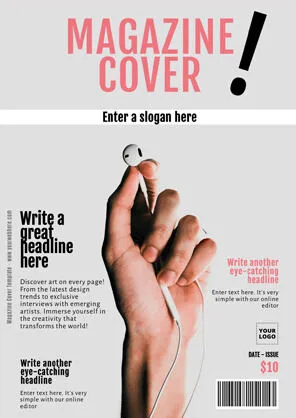
Magazine Covers

Book & eBook Covers
Pasco-Hernando State College
APA Page Format
- Finding and Evaluating Sources (Critical Analysis)
- Synthesizing Information from Sources
- MLA Documentation
- APA In-Text Citations
- Writing a Research Paper
- APA Handout
- Acceptable fonts and sizes: Size 12-point Times New Roman;11-point Arial, Calibri, and Georgia; or 10-point Lucida.
- Body of paper is aligned left
- Running head (by instructor preference) in header, left aligned
- Page number in header right aligned
- Line Spacing – double throughout
- Tab in the first line of a paragraph ½” or .5
- Title is bolded, centered with proper capitalization
- Level 1 heading on 2nd page of paper, centered and bolded and is usually the title of the paper, never the word Introduction.
- References is the last page of the paper
- 1” margins – top, bottom, left, right.
- Word margins are set in Layout or in File/Page Setup/Margins.
- Acceptable fonts and sizes: Size 12-point Times New Roman; 11-point Arial, Calibri, and Georgia;10-point Lucida; or other legible font as approved by instructor.
- Font and font size are important for readability.
- Do not use bold except for section headings if section headings are used.
- Do not use all caps except for the title of the paper in the Header or an acronym (NATO, AIDS).
- Do not use italics or underlining unless there is a rule that says to use them.
- Left align – this is the usual default setting.
- Do not block or justify where the right margin is uneven.
- Alignment can be set in the Paragraph box if the icon is not visible.
Line Spacing
- Double space –throughout the entire document.
- Check default settings in the Paragraph box and reset per instructions under Paragraph setting (see below).
Paragraph Settings
Some programs such as Word 2007 and later have defaults in the Paragraph box which interferes with proper double spacing. The settings in the Paragraph dialogue box should be as follows to have proper double spacing.
- Indentation (on top) should be set at 0 left and 0 right.
- Spacing (on the lower left) should be set to 0 Before and 0 After.
- Line Spacing (on the lower right) should be set to double.
- Check the box that says “Don’t add space between paragraphs of the same style.”
- Click Default (at the bottom) and select Yes to change defaults.
In Google docs , you can change Paragraph settings under Spacing to 0 next to Before and 0 next to After by going into the double spacing tool and clicking Custom Settings. You will have to select (highlight) the entire paper including the heading in the upper left before making the change once the paper is typed.
In Pages , you can change the Paragraph settings by clicking on Format on the top navigation bar and then Paragraph. Remember that you have to highlight (select) the entire paper including the heading in the upper left before making change in Paragraph once the paper is typed.
First Line of a Paragraph
- Indent the first word of a paragraph 1/2” or .5 from the left margin.
- The Tab default is usually at this setting. If not, reset defaults.
Spacing after a Period or Other End Punctuation
In the 7th edition of APA, only one space is used after the end of a sentence.
Page Number and Running Head
- In Word, click on the Insert tab and then click on Page Number in the menu bar. It will give you the option of where to insert the page number.
- Choose to insert the page number at the top of the page, right aligned.
- The page number appears on every page of the document, including the title page.
- Place the cursor left of the number and type in the running head.
- Total length of the running head is 50 characters and spaces.
- The running head is in all caps.
- After you typed click tab until the running head is left aligned in the header.
- Use a plain header format.
- Do not use bold, underlining, quotation marks, or a different font or color for the title.
- Do not use the word page or any abbreviation of the word page such as pg. or p. between the running head and the actual page number.
Heading Levels
There are five possible heading levels in APA style.
- Level 1 headings are used for top-level or main sections – they are bolded and in the center of the page.
- Level 2 and Level 3 headings are subsections of Level 1 – they are also bolded, but they are left aligned.
- Levels 4 and 5 headings are bolded, italicized, indented, and followed by a period.
APA does not use the word Introduction. The Level 1 heading at the beginning of an APA paper is the bolded and centered title of the paper, typed on the first page of the paper after the title page.
See pages 47 - 49 in the APA Publication Manual for more detailed information.
The student paper must include a title page. The following items are included on the student title page unless otherwise indicated by the instructor:
- The running head is an abbreviation of the title, written in all-caps, left aligned in the header up to 50 character and spaces long (if less than 50 character and spaces long then the entire title can be in the header)
- Page number is right aligned in the header
- The running head and page numbers appear on every page of the paper.
- All the text on the title page is centered and double spaced with proper capitalization (except for the header)
- Title is a maximum of three to four spaces below the header
- Directly below the title is the student author’s first and last name
- On the next line is the college/institution’s name, fully spelled out with proper capitalization
- Below the institution name is the course number and course name, ex: COU 1234: Introduction to APA Usage
- On the next line is the instructor name, ex: Prof. I. Knowalot
- On the last line is the assignment due date, ex: February 29, 2028
If you are asked to prepare an abstract for your research paper, click Insert/Page Break to get to the top of a new page, and center the word Abstract in bold on the first line. Abstracts are typically no more than 250 words. They are usually a single paragraph with no indentation at the start of the paragraph. Otherwise, they follow the same formatting rules including double spacing.
Reference Page
- After the last section of your paper insert a page break.
- Type the word References, bolded, centered with proper capitalization
- The References page is double spaced.
- Each reference entry is left-aligned and formatted with a hanging indent.
- To create the hanging indent, highlight the reference entries and go into the Paragraph box.
- Under Special, select Hanging from the drop down menu. Once selected, the default under By should be .5’.
- Remember that your list has to be alphabetized by author. If there is no author or group author, use the title.
- There are no extra spaces in between entries.
- Printer-friendly version


Understanding Assignments
What this handout is about.
The first step in any successful college writing venture is reading the assignment. While this sounds like a simple task, it can be a tough one. This handout will help you unravel your assignment and begin to craft an effective response. Much of the following advice will involve translating typical assignment terms and practices into meaningful clues to the type of writing your instructor expects. See our short video for more tips.
Basic beginnings
Regardless of the assignment, department, or instructor, adopting these two habits will serve you well :
- Read the assignment carefully as soon as you receive it. Do not put this task off—reading the assignment at the beginning will save you time, stress, and problems later. An assignment can look pretty straightforward at first, particularly if the instructor has provided lots of information. That does not mean it will not take time and effort to complete; you may even have to learn a new skill to complete the assignment.
- Ask the instructor about anything you do not understand. Do not hesitate to approach your instructor. Instructors would prefer to set you straight before you hand the paper in. That’s also when you will find their feedback most useful.
Assignment formats
Many assignments follow a basic format. Assignments often begin with an overview of the topic, include a central verb or verbs that describe the task, and offer some additional suggestions, questions, or prompts to get you started.
An Overview of Some Kind
The instructor might set the stage with some general discussion of the subject of the assignment, introduce the topic, or remind you of something pertinent that you have discussed in class. For example:
“Throughout history, gerbils have played a key role in politics,” or “In the last few weeks of class, we have focused on the evening wear of the housefly …”
The Task of the Assignment
Pay attention; this part tells you what to do when you write the paper. Look for the key verb or verbs in the sentence. Words like analyze, summarize, or compare direct you to think about your topic in a certain way. Also pay attention to words such as how, what, when, where, and why; these words guide your attention toward specific information. (See the section in this handout titled “Key Terms” for more information.)
“Analyze the effect that gerbils had on the Russian Revolution”, or “Suggest an interpretation of housefly undergarments that differs from Darwin’s.”
Additional Material to Think about
Here you will find some questions to use as springboards as you begin to think about the topic. Instructors usually include these questions as suggestions rather than requirements. Do not feel compelled to answer every question unless the instructor asks you to do so. Pay attention to the order of the questions. Sometimes they suggest the thinking process your instructor imagines you will need to follow to begin thinking about the topic.
“You may wish to consider the differing views held by Communist gerbils vs. Monarchist gerbils, or Can there be such a thing as ‘the housefly garment industry’ or is it just a home-based craft?”
These are the instructor’s comments about writing expectations:
“Be concise”, “Write effectively”, or “Argue furiously.”
Technical Details
These instructions usually indicate format rules or guidelines.
“Your paper must be typed in Palatino font on gray paper and must not exceed 600 pages. It is due on the anniversary of Mao Tse-tung’s death.”
The assignment’s parts may not appear in exactly this order, and each part may be very long or really short. Nonetheless, being aware of this standard pattern can help you understand what your instructor wants you to do.
Interpreting the assignment
Ask yourself a few basic questions as you read and jot down the answers on the assignment sheet:
Why did your instructor ask you to do this particular task?
Who is your audience.
- What kind of evidence do you need to support your ideas?
What kind of writing style is acceptable?
- What are the absolute rules of the paper?
Try to look at the question from the point of view of the instructor. Recognize that your instructor has a reason for giving you this assignment and for giving it to you at a particular point in the semester. In every assignment, the instructor has a challenge for you. This challenge could be anything from demonstrating an ability to think clearly to demonstrating an ability to use the library. See the assignment not as a vague suggestion of what to do but as an opportunity to show that you can handle the course material as directed. Paper assignments give you more than a topic to discuss—they ask you to do something with the topic. Keep reminding yourself of that. Be careful to avoid the other extreme as well: do not read more into the assignment than what is there.
Of course, your instructor has given you an assignment so that they will be able to assess your understanding of the course material and give you an appropriate grade. But there is more to it than that. Your instructor has tried to design a learning experience of some kind. Your instructor wants you to think about something in a particular way for a particular reason. If you read the course description at the beginning of your syllabus, review the assigned readings, and consider the assignment itself, you may begin to see the plan, purpose, or approach to the subject matter that your instructor has created for you. If you still aren’t sure of the assignment’s goals, try asking the instructor. For help with this, see our handout on getting feedback .
Given your instructor’s efforts, it helps to answer the question: What is my purpose in completing this assignment? Is it to gather research from a variety of outside sources and present a coherent picture? Is it to take material I have been learning in class and apply it to a new situation? Is it to prove a point one way or another? Key words from the assignment can help you figure this out. Look for key terms in the form of active verbs that tell you what to do.
Key Terms: Finding Those Active Verbs
Here are some common key words and definitions to help you think about assignment terms:
Information words Ask you to demonstrate what you know about the subject, such as who, what, when, where, how, and why.
- define —give the subject’s meaning (according to someone or something). Sometimes you have to give more than one view on the subject’s meaning
- describe —provide details about the subject by answering question words (such as who, what, when, where, how, and why); you might also give details related to the five senses (what you see, hear, feel, taste, and smell)
- explain —give reasons why or examples of how something happened
- illustrate —give descriptive examples of the subject and show how each is connected with the subject
- summarize —briefly list the important ideas you learned about the subject
- trace —outline how something has changed or developed from an earlier time to its current form
- research —gather material from outside sources about the subject, often with the implication or requirement that you will analyze what you have found
Relation words Ask you to demonstrate how things are connected.
- compare —show how two or more things are similar (and, sometimes, different)
- contrast —show how two or more things are dissimilar
- apply—use details that you’ve been given to demonstrate how an idea, theory, or concept works in a particular situation
- cause —show how one event or series of events made something else happen
- relate —show or describe the connections between things
Interpretation words Ask you to defend ideas of your own about the subject. Do not see these words as requesting opinion alone (unless the assignment specifically says so), but as requiring opinion that is supported by concrete evidence. Remember examples, principles, definitions, or concepts from class or research and use them in your interpretation.
- assess —summarize your opinion of the subject and measure it against something
- prove, justify —give reasons or examples to demonstrate how or why something is the truth
- evaluate, respond —state your opinion of the subject as good, bad, or some combination of the two, with examples and reasons
- support —give reasons or evidence for something you believe (be sure to state clearly what it is that you believe)
- synthesize —put two or more things together that have not been put together in class or in your readings before; do not just summarize one and then the other and say that they are similar or different—you must provide a reason for putting them together that runs all the way through the paper
- analyze —determine how individual parts create or relate to the whole, figure out how something works, what it might mean, or why it is important
- argue —take a side and defend it with evidence against the other side
More Clues to Your Purpose As you read the assignment, think about what the teacher does in class:
- What kinds of textbooks or coursepack did your instructor choose for the course—ones that provide background information, explain theories or perspectives, or argue a point of view?
- In lecture, does your instructor ask your opinion, try to prove their point of view, or use keywords that show up again in the assignment?
- What kinds of assignments are typical in this discipline? Social science classes often expect more research. Humanities classes thrive on interpretation and analysis.
- How do the assignments, readings, and lectures work together in the course? Instructors spend time designing courses, sometimes even arguing with their peers about the most effective course materials. Figuring out the overall design to the course will help you understand what each assignment is meant to achieve.
Now, what about your reader? Most undergraduates think of their audience as the instructor. True, your instructor is a good person to keep in mind as you write. But for the purposes of a good paper, think of your audience as someone like your roommate: smart enough to understand a clear, logical argument, but not someone who already knows exactly what is going on in your particular paper. Remember, even if the instructor knows everything there is to know about your paper topic, they still have to read your paper and assess your understanding. In other words, teach the material to your reader.
Aiming a paper at your audience happens in two ways: you make decisions about the tone and the level of information you want to convey.
- Tone means the “voice” of your paper. Should you be chatty, formal, or objective? Usually you will find some happy medium—you do not want to alienate your reader by sounding condescending or superior, but you do not want to, um, like, totally wig on the man, you know? Eschew ostentatious erudition: some students think the way to sound academic is to use big words. Be careful—you can sound ridiculous, especially if you use the wrong big words.
- The level of information you use depends on who you think your audience is. If you imagine your audience as your instructor and they already know everything you have to say, you may find yourself leaving out key information that can cause your argument to be unconvincing and illogical. But you do not have to explain every single word or issue. If you are telling your roommate what happened on your favorite science fiction TV show last night, you do not say, “First a dark-haired white man of average height, wearing a suit and carrying a flashlight, walked into the room. Then a purple alien with fifteen arms and at least three eyes turned around. Then the man smiled slightly. In the background, you could hear a clock ticking. The room was fairly dark and had at least two windows that I saw.” You also do not say, “This guy found some aliens. The end.” Find some balance of useful details that support your main point.
You’ll find a much more detailed discussion of these concepts in our handout on audience .
The Grim Truth
With a few exceptions (including some lab and ethnography reports), you are probably being asked to make an argument. You must convince your audience. It is easy to forget this aim when you are researching and writing; as you become involved in your subject matter, you may become enmeshed in the details and focus on learning or simply telling the information you have found. You need to do more than just repeat what you have read. Your writing should have a point, and you should be able to say it in a sentence. Sometimes instructors call this sentence a “thesis” or a “claim.”
So, if your instructor tells you to write about some aspect of oral hygiene, you do not want to just list: “First, you brush your teeth with a soft brush and some peanut butter. Then, you floss with unwaxed, bologna-flavored string. Finally, gargle with bourbon.” Instead, you could say, “Of all the oral cleaning methods, sandblasting removes the most plaque. Therefore it should be recommended by the American Dental Association.” Or, “From an aesthetic perspective, moldy teeth can be quite charming. However, their joys are short-lived.”
Convincing the reader of your argument is the goal of academic writing. It doesn’t have to say “argument” anywhere in the assignment for you to need one. Look at the assignment and think about what kind of argument you could make about it instead of just seeing it as a checklist of information you have to present. For help with understanding the role of argument in academic writing, see our handout on argument .
What kind of evidence do you need?
There are many kinds of evidence, and what type of evidence will work for your assignment can depend on several factors–the discipline, the parameters of the assignment, and your instructor’s preference. Should you use statistics? Historical examples? Do you need to conduct your own experiment? Can you rely on personal experience? See our handout on evidence for suggestions on how to use evidence appropriately.
Make sure you are clear about this part of the assignment, because your use of evidence will be crucial in writing a successful paper. You are not just learning how to argue; you are learning how to argue with specific types of materials and ideas. Ask your instructor what counts as acceptable evidence. You can also ask a librarian for help. No matter what kind of evidence you use, be sure to cite it correctly—see the UNC Libraries citation tutorial .
You cannot always tell from the assignment just what sort of writing style your instructor expects. The instructor may be really laid back in class but still expect you to sound formal in writing. Or the instructor may be fairly formal in class and ask you to write a reflection paper where you need to use “I” and speak from your own experience.
Try to avoid false associations of a particular field with a style (“art historians like wacky creativity,” or “political scientists are boring and just give facts”) and look instead to the types of readings you have been given in class. No one expects you to write like Plato—just use the readings as a guide for what is standard or preferable to your instructor. When in doubt, ask your instructor about the level of formality they expect.
No matter what field you are writing for or what facts you are including, if you do not write so that your reader can understand your main idea, you have wasted your time. So make clarity your main goal. For specific help with style, see our handout on style .
Technical details about the assignment
The technical information you are given in an assignment always seems like the easy part. This section can actually give you lots of little hints about approaching the task. Find out if elements such as page length and citation format (see the UNC Libraries citation tutorial ) are negotiable. Some professors do not have strong preferences as long as you are consistent and fully answer the assignment. Some professors are very specific and will deduct big points for deviations.
Usually, the page length tells you something important: The instructor thinks the size of the paper is appropriate to the assignment’s parameters. In plain English, your instructor is telling you how many pages it should take for you to answer the question as fully as you are expected to. So if an assignment is two pages long, you cannot pad your paper with examples or reword your main idea several times. Hit your one point early, defend it with the clearest example, and finish quickly. If an assignment is ten pages long, you can be more complex in your main points and examples—and if you can only produce five pages for that assignment, you need to see someone for help—as soon as possible.
Tricks that don’t work
Your instructors are not fooled when you:
- spend more time on the cover page than the essay —graphics, cool binders, and cute titles are no replacement for a well-written paper.
- use huge fonts, wide margins, or extra spacing to pad the page length —these tricks are immediately obvious to the eye. Most instructors use the same word processor you do. They know what’s possible. Such tactics are especially damning when the instructor has a stack of 60 papers to grade and yours is the only one that low-flying airplane pilots could read.
- use a paper from another class that covered “sort of similar” material . Again, the instructor has a particular task for you to fulfill in the assignment that usually relates to course material and lectures. Your other paper may not cover this material, and turning in the same paper for more than one course may constitute an Honor Code violation . Ask the instructor—it can’t hurt.
- get all wacky and “creative” before you answer the question . Showing that you are able to think beyond the boundaries of a simple assignment can be good, but you must do what the assignment calls for first. Again, check with your instructor. A humorous tone can be refreshing for someone grading a stack of papers, but it will not get you a good grade if you have not fulfilled the task.
Critical reading of assignments leads to skills in other types of reading and writing. If you get good at figuring out what the real goals of assignments are, you are going to be better at understanding the goals of all of your classes and fields of study.
You may reproduce it for non-commercial use if you use the entire handout and attribute the source: The Writing Center, University of North Carolina at Chapel Hill
Make a Gift
- Utility Menu
- Writing Center
- Writing Program
- Designing Essay Assignments
by Gordon Harvey
Students often do their best and hardest thinking, and feel the greatest sense of mastery and growth, in their writing. Courses and assignments should be planned with this in mind. Three principles are paramount:
1. Name what you want and imagine students doing it
However free students are to range and explore in a paper, the general kind of paper you’re inviting has common components, operations, and criteria of success, and you should make these explicit. Having satisfied yourself, as you should, that what you’re asking is doable, with dignity, by writers just learning the material, try to anticipate in your prompt or discussions of the assignment the following queries:
- What is the purpose of this? How am I going beyond what we have done, or applying it in a new area, or practicing a key academic skill or kind of work?
- To what audience should I imagine myself writing?
- What is the main task or tasks, in a nutshell? What does that key word (e.g., analyze, significance of, critique, explore, interesting, support) really mean in this context or this field?
- What will be most challenging in this and what qualities will most distinguish a good paper? Where should I put my energy? (Lists of possible questions for students to answer in a paper are often not sufficiently prioritized to be helpful.)
- What misconceptions might I have about what I’m to do? (How is this like or unlike other papers I may have written?) Are there too-easy approaches I might take or likely pitfalls? An ambitious goal or standard that I might think I’m expected to meet but am not?
- What form will evidence take in my paper (e.g., block quotations? paraphrase? graphs or charts?) How should I cite it? Should I use/cite material from lecture or section?
- Are there some broad options for structure, emphasis, or approach that I’ll likely be choosing among?
- How should I get started on this? What would be a helpful (or unhelpful) way to take notes, gather data, discover a question or idea? Should I do research?
2. Take time in class to prepare students to succeed at the paper
Resist the impulse to think of class meetings as time for “content” and of writing as work done outside class. Your students won’t have mastered the art of paper writing (if such a mastery is possible) and won’t know the particular disciplinary expectations or moves relevant to the material at hand. Take time in class to show them:
- discuss the assignment in class when you give it, so students can see that you take it seriously, so they can ask questions about it, so they can have it in mind during subsequent class discussions;
- introduce the analytic vocabulary of your assignment into class discussions, and take opportunities to note relevant moves made in discussion or good paper topics that arise;
- have students practice key tasks in class discussions, or in informal writing they do in before or after discussions;
- show examples of writing that illustrates components and criteria of the assignment and that inspires (class readings can sometimes serve as illustrations of a writing principle; so can short excerpts of writing—e.g., a sampling of introductions; and so can bad writing—e.g., a list of problematic thesis statements);
- the topics of originality and plagiarism (what the temptations might be, how to avoid risks) should at some point be addressed directly.
3. Build in process
Ideas develop over time, in a process of posing and revising and getting feedback and revising some more. Assignments should allow for this process in the following ways:
- smaller assignments should prepare for larger ones later;
- students should do some thinking and writing before they write a draft and get a response to it (even if only a response to a proposal or thesis statement sent by email, or described in class);
- for larger papers, students should write and get response (using the skills vocabulary of the assignment) to a draft—at least an “oral draft” (condensed for delivery to the class);
- if possible, meet with students individually about their writing: nothing inspires them more than feeling that you care about their work and development;
- let students reflect on their own writing, in brief cover letters attached to drafts and revisions (these may also ask students to perform certain checks on what they have written, before submitting);
- have clear and firm policies about late work that nonetheless allow for exception if students talk to you in advance.
- Pedagogy Workshops
- Responding to Student Writing
- Commenting Efficiently
- Vocabulary for Discussing Student Writing
- Guides to Teaching Writing
- HarvardWrites Instructor Toolkit
- Additional Resources for Teaching Fellows
28+ Best Free Assignment Cover Page Formats for MS Word
What is an assignment cover page, key elements for a comprehensive front page.
- Institution Details: Begin by prominently featuring the name of your school, college, or institute. This establishes credibility and provides context for your assignment.
- Personal Information: Include your own name to indicate authorship and ownership of the assignment. This adds a personal touch and facilitates easy identification.
- Assignment Title: Clearly state the title of your assignment, conveying its purpose and focus. A concise and informative title sets the tone for your work.
- Course Information: Specify the relevant course title or code to indicate the academic context in which your assignment was completed. This assists in proper categorization and organization.
- Instructor’s Name: Acknowledge the teacher or professor who will be evaluating your assignment by including their name. This demonstrates respect and professionalism.
- Due Date: Clearly indicate the deadline or due date for the assignment submission. This ensures timely assessment and helps you stay organized.
What are the basic tips?
- Font style : It is always in the best interest to use bold, simple, and clear text instead of using fancy text fonts and styles. This helps the reader understand things in a better way. Moreover, the usage of pictures behind texts must be avoided as it creates poor visibility for the reader when reading the text printed on it.
- Presentation: Presentation plays an important role in expressing what you need to convey to someone and how you need to communicate it. Presenting the title page in the most effective manner is essential as this leaves an impression on the teacher reading the assignment. It also acts as a decisive tool for the teacher whether or not he/ she interestingly goes through the whole document.
- Spell Check: Before handing over the assignment, one should take a brief review of all the spelling and also look for any grammatical errors.
- Avoid plagiarism: A student must always be honest in what he writes. He should avoid copying material or texts from anywhere.
- Personal detail: One should never forget to mention his/her name. The font size used for writing the name must be bigger so that it makes the name visible to the teacher.
Advantages of an Impressive Assignment Cover Page
- Showcasing Professionalism: By meticulously designing your cover page, you demonstrate a strong commitment to professionalism. This attention to detail reflects positively on your work ethic and sets you apart as a dedicated student.
- Creating a Positive Impression: A well-crafted front page sets the tone for your assignment, capturing the attention of your teacher or professor. It establishes a positive first impression, arousing their interest and encouraging them to delve further into your work.
- Enhancing Visual Appeal: A visually appealing cover page enhances the overall presentation of your assignment. With carefully chosen fonts, colors, and layouts, you create an engaging and aesthetically pleasing introduction that captivates the reader’s attention.
- Communicating Pertinent Information: It provides a concise summary of essential details, such as the assignment title, your name, and the due date. This ensures clarity and facilitates seamless identification and organization of your work.
- Reflecting a Professional Attitude: By dedicating time and effort to creating an impressive cover page, you exemplify a professional attitude towards your academic pursuits. This level of dedication and care leaves a lasting impression on your teacher or professor.

Download Free Cover Page Templates
#1 – best format.

#2 – Assignment Cover Page for Case Study
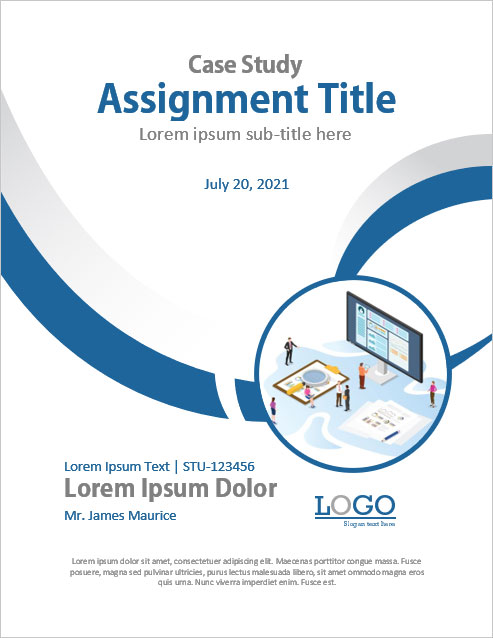
#3 – Best Design for Critical Review
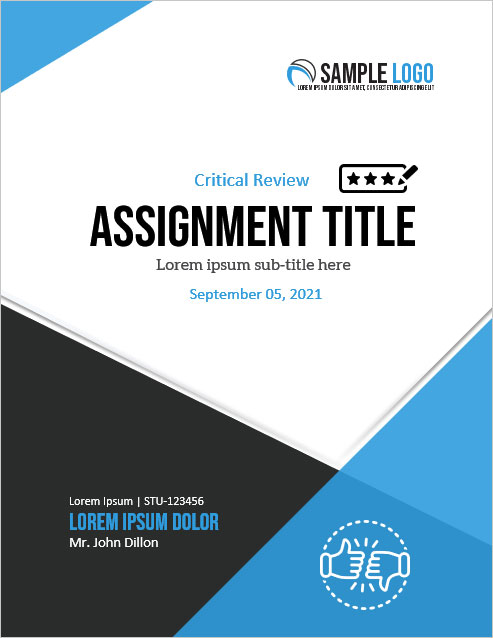
#4 – For Any Kind of Educational Assignment
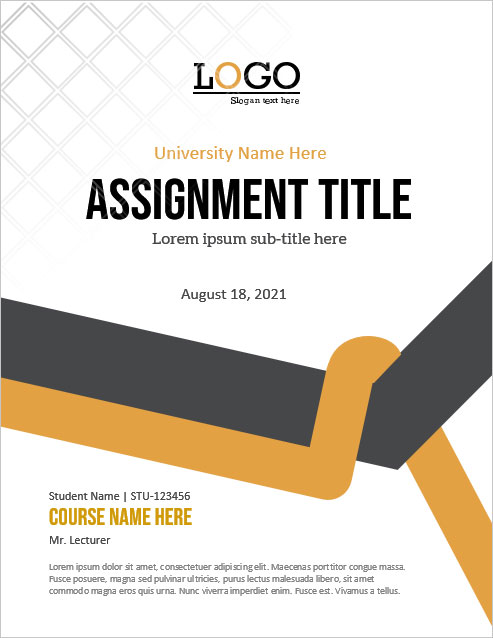
Video Tutorial
#5 – essay assignment.
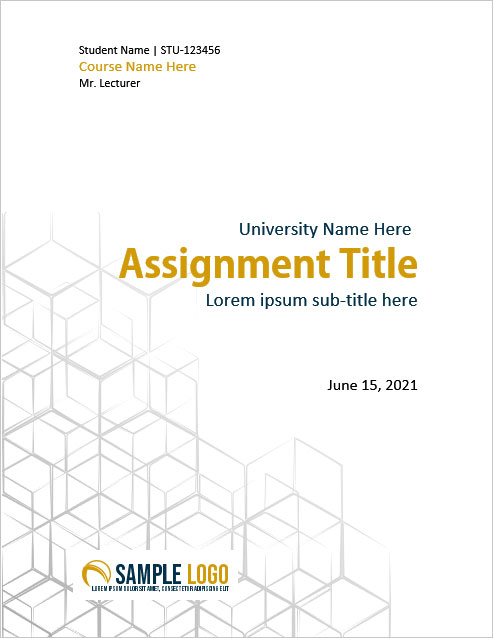
#6 – Syllabus Assignment
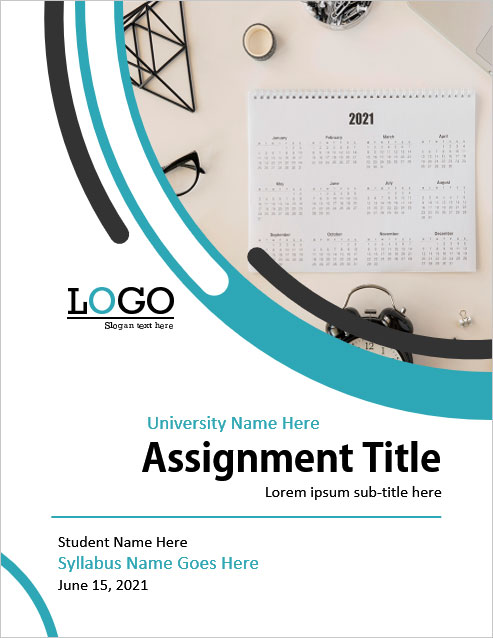
#7 – Cover Page For University Assignments
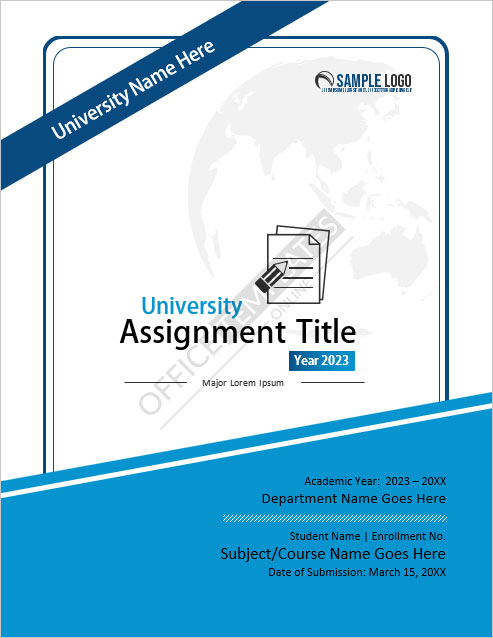
#14 – Cover Page for Business Assignment
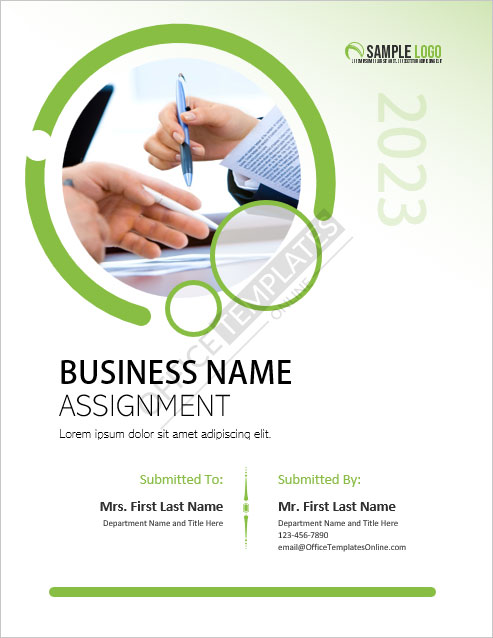
#16 – Academic
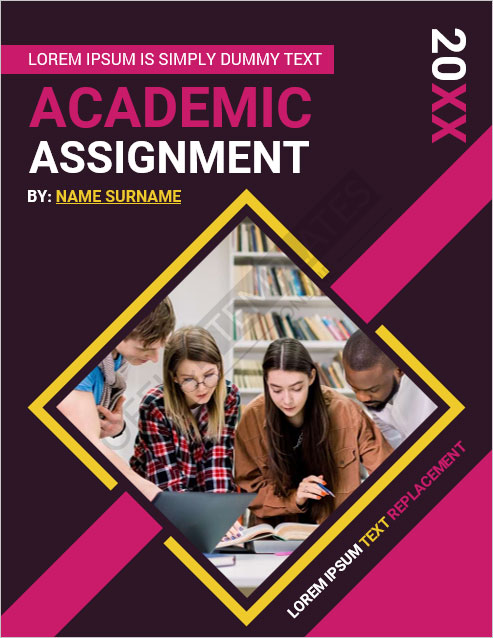
#17 – Generic Cover Page for any Assignment
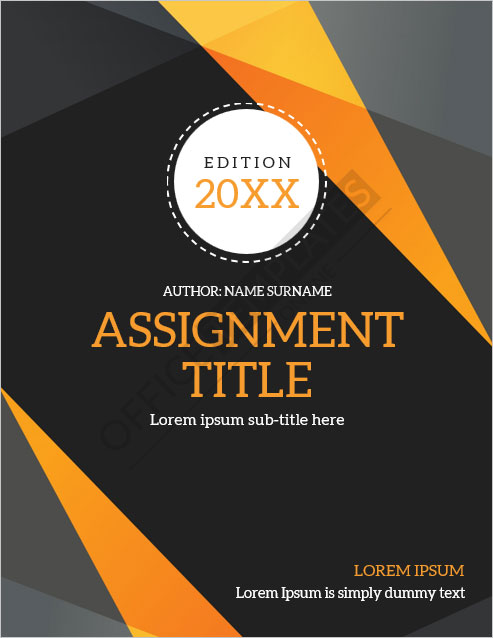
#18 – Biology Assignment
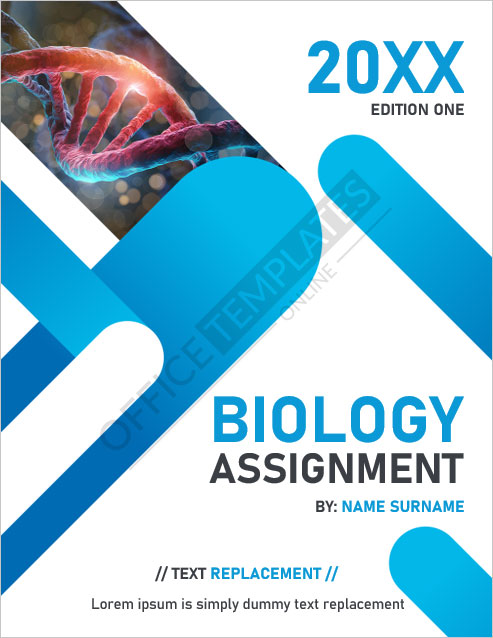
#19 – For Chemistry Projects

#20 – Cover Page for Computer Projects
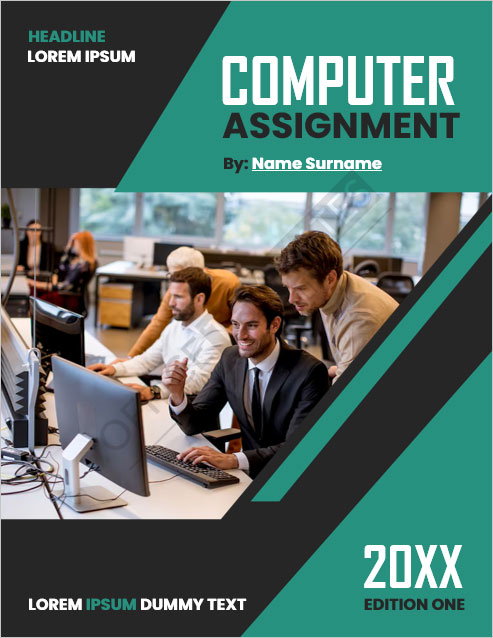
#21 – For Engineering-Related Assignments
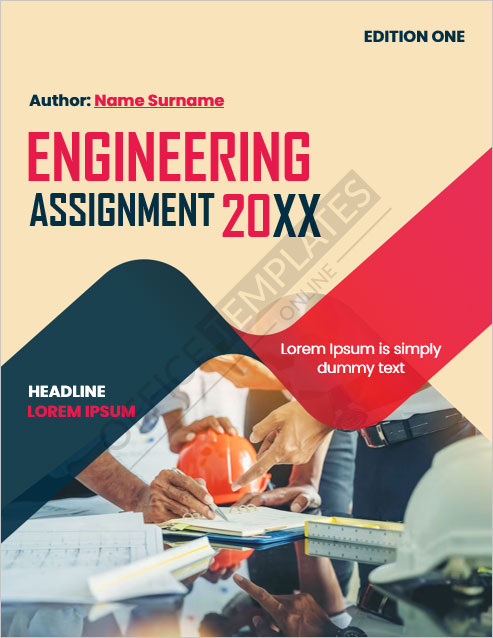
#22 – For English Assignment
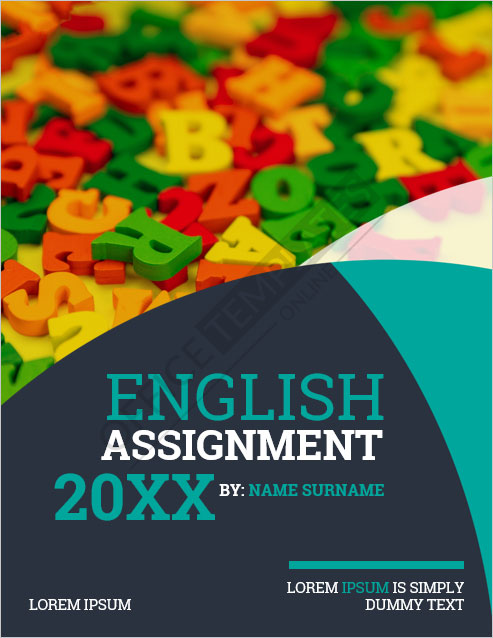
#23 – For Geography Projects
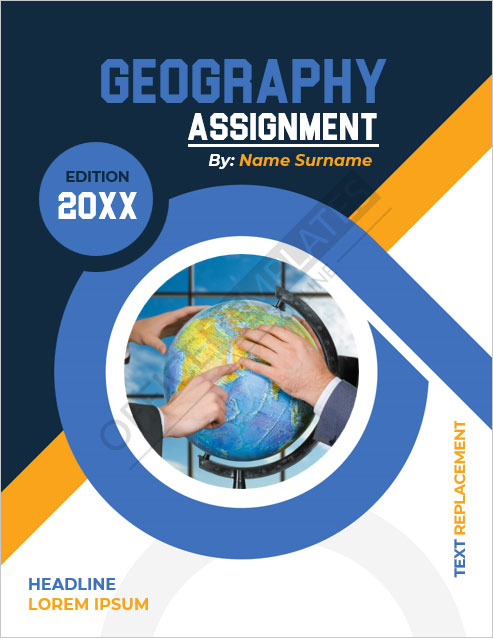
#24 – Mathematics
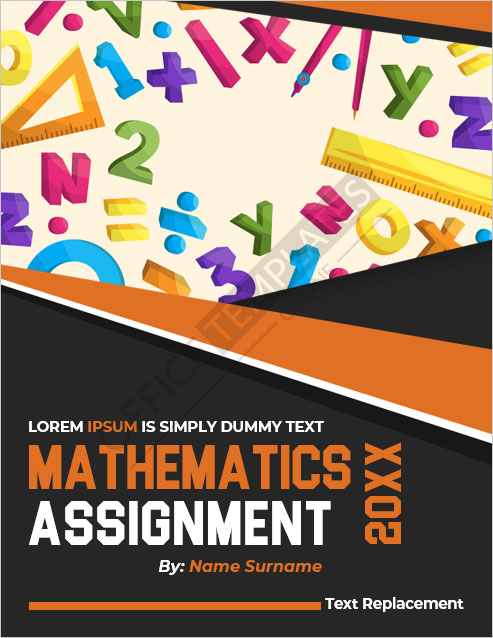
#25 – Physics

#26 – Cover Page for School Assignments

#27 – Best for Science Projects

#28 – For Social Study Assignment

Versatile Designs and Layouts for Every Purpose
- Assignment Types: Our templates are designed specifically for different types of assignments, such as case studies, critical reviews, essays, syllabi, and business projects. Each template is tailored to suit the requirements and objectives of its respective assignment type.
- Academic Disciplines: Our collection includes templates suitable for various academic disciplines like biology, chemistry, computer science, engineering, English, geography, mathematics, physics, and social studies. Each template aligns with the themes and aesthetics of its corresponding discipline.
- Purposes: Whether you are a student, educator, or professional, our templates serve multiple purposes. They can be used for university assignments, school projects, research papers, or any academic or professional endeavor that requires a polished cover page.
- Designs, Layouts, and Styles: Our templates offer a diverse range of designs, from minimalistic and clean to visually captivating and sophisticated. You can choose from different layouts that creatively arrange text, images, and graphics. Our templates cater to a variety of styles, ensuring there is something for everyone’s preferences.
User-Friendly Customization: Make It Your Own
- Easy Modifications: We believe in keeping things simple. With just a few clicks, you can effortlessly modify our templates to suit your specific requirements. Change colors, fonts, and layouts with ease, and watch your cover page transform before your eyes.
- Colors and Themes: Infuse it with the perfect color scheme and themes that truly represent your assignment. Our templates offer a wide range of options, so you can find the ideal palette and theme that resonate with your content.
- Font Selection: The right font can make all the difference. Choose from our diverse selection of fonts to enhance the visual appeal and readability. From elegant and professional to modern and bold, we have fonts to suit every style.
- Layout Flexibility: It should reflect your unique presentation style. With our templates, you have the freedom to experiment with different layouts, arranging titles, subtitles, images, and text blocks in a way that best suits your assignment.
Benefits of Using Professionally Designed Templates: Make an Impact with Ease
- Time and Effort Saving: Our professionally designed templates eliminate the need to start from scratch. With pre-designed layouts, styles, and graphics, you can save valuable time and effort in creating visually appealing front pages. Simply customize the template to suit your assignment’s requirements, and you’re ready to impress.
- Consistency and Professionalism: Using our templates ensures consistency in your assignment submissions. The standardized design elements and formatting guidelines help maintain a professional appearance throughout your work. Presenting your assignments with a polished title page enhances the overall quality and credibility of your content.
- Visual Appeal: A visually appealing title page grabs attention and sets the tone for your assignment. Our templates are thoughtfully crafted by design professionals, incorporating aesthetically pleasing elements, color schemes, and typography. By leveraging these designs, you can effortlessly create eye-catching cover pages that captivate your professors or readers.
- Positive Impression: First impressions matter, and a well-designed cover page leaves a positive impact on professors and readers alike. Showcasing your assignment in a professional and visually appealing manner demonstrates your dedication and attention to detail. It sets the stage for an engaging reading experience, encouraging your audience to delve deeper into your work.
- User-Friendly Customization: Our templates are designed to be easily customizable, allowing you to add your personal touch without technical expertise. You can modify text, colors, images, and other elements to align with your assignment’s theme and requirements. This flexibility ensures that your cover page reflects your unique style while maintaining a professional look.
Tips for Maximizing the Impact: Make Your Cover Page Stand Out
- Choose Colors Wisely: Select colors that complement your assignment’s theme and evoke the desired emotions. Vibrant colors can grab attention, while muted tones create a sense of elegance. Maintain consistency with your assignment’s overall design and avoid using too many colors that may distract from the main message.
- Opt for Legible Fonts: Use clear and readable fonts to enhance the accessibility and professionalism of your cover page. Avoid overly decorative or complex fonts that may hinder readability. Opt for fonts that align with your assignment’s tone and maintain consistency throughout the document.
- Incorporate Relevant Graphics: Graphics can enhance the visual appeal of your cover page and reinforce the assignment’s subject matter. Choose images or icons that are directly related to the topic or convey the assignment’s main concept. Ensure that the graphics are high-quality and appropriately sized to maintain clarity.
- Organize Information Effectively: Arrange the information in a logical and visually appealing manner. Use headings, subheadings, and bullet points to break down content and make it easier to read. Highlight key details such as the assignment title, your name, course information, and submission date.
- Maintain Simplicity: While it’s important to make it visually appealing, avoid cluttering it with excessive elements. Keep the design clean and uncluttered, allowing the key information to stand out. Remember, simplicity often has a greater impact than complexity.
- Preview and Proofread: Before finalizing, preview it to ensure that all elements are properly aligned and visually balanced. Proofread the content to eliminate any spelling or grammatical errors. A polished and error-free cover demonstrates your attention to detail and professionalism.
← Previous Article
Next Article →
You may also like

- Memorial Day Cards
- Doctor Prescription Pad Formats
- Printable ID Cards
- Creative Resume Formats for Freshers
- Modern Resume Templates
- Best Cover Page Formats
- Printable Report Cards
- Business Proposal Templates
- 22 Raffle Ticket Templates
- Free Certificate Templates
Search the database of 10,000+ templates, designs & formats for Microsoft Office.
- Share Your Appreciation: Free Memorial Day Card Templates
- Crafted with Love: Free Mother’s Day Cards to Warm Mom’s Heart
- Stand Out from the Crowd: 6+ Free Fact Sheet Templates
- Make Your Mark: Free Printable Dog Name Tags for Every Tail-Wagger!
- 7+ Free Stunning Easter Templates for Joyful Celebrations
- 9+ Free Admit-One Ticket Templates: Flexible and Easy to Edit
- Get Cooking with Style: 8+ Free Customizable Recipe Card Templates
- 11+ Free Mortgage Flyer Templates to Elevate Your Marketing
- Enhance Your Events with 20+ Unique and Free Ticket Voucher Templates
- Relaxation Redefined: Explore Free 8+ Spa Voucher Templates
- 24+ Free Employment Verification Letter Templates
- Free 5+ Best Christmas Wishlist Templates for Joyful Giving
- Certificates
- Cover Pages
- Educational
- Event Templates
- Invoices & Receipts
- Letterheads
- Office Related
- Personal Use
- 137+ Professional Reports – MS Word & Excel
- 70+ Printable & Editable ID Card Designs
- 59+ Proposal Formats
- 31+ Best Flyer Designs & Formats
- 100+ Cover Page Templates
- 22+ Free Letterhead Designs and Formats
- 24+ Free Resume Designs & for Freshers and Professionals
- 136+ Printable Certificate Templates
- 55+ Quotations & Invoices
- Create FREE PDF Calendar Online

An APA Guide for Students and Faculty

APA Assignment: General Page Format Requirements
Academic writing at Confederation College must always be formatted according to APA guidelines.
How to Format an APA Document
Use one of the following APA fonts: 12 pt. font, Times New Roman or 11 pt. font, Calibri (Body).
How to Change the Font Size.
To change the font, click on the “Home” tab in Microsoft Word, and choose the style and font size in the dropdown menus (A and B), as pictured in Figure 1.

Page Margins
Your document must have 1” (one inch) page margins on the top, sides, and bottom of the document.
How to Check the Page Margin Size.
Click the “Layout” tab (A) in Microsoft Word, and click the “Margins” drop-down arrow (B). Click on the “Normal (2.54 cm)” margin selection (C), as pictured in Figure 2.

Paragraph Alignment
All assignment paragraphs (for essays, formal reports, or informal reports) must be ragged, left aligned. You should never manually adjust the word spacing or hyphenate any words to make the paragraph flush with both margins.
How to Make an Assignment Left Aligned.
Under the “Home” tab, click the left align button (A), as shown in Figure 3.

APA Assignments: How to Format Mandatory Components
There are mandatory components that, unless otherwise indicated by your Confederation College professor, must accompany all assignments that you submit. Every assignment must have an APA title page, and if you have taken any information from a secondary source, you must also include an APA References page. See the References section of this guide for the References page formatting instructions.
APA Title Page
Your APA title page is the first page of your assignment, and it must abide by APA guidelines. Follow the long instructions in Figure 6 or use the short instructions in Figure 5 to create an APA title page
If you have followed the directions to create an APA title page, the layout of your APA title page should look exactly like the title page in Figure 4. If it does not look identical, you have missed a step, and therefore, your APA title page is formatted incorrectly.

How to Create an APA Title Page

APA References Page
The References page contains a list of all of the sources that you paraphrased, quoted, or summarized in your paper. See the “Avoiding Plagiarism” section for more information about what sources you need to cite and reference. See the “References” section of this guide for more information about how to format the References page and how to create each reference entry.
Word & Excel Templates
Printable Word and Excel Templates
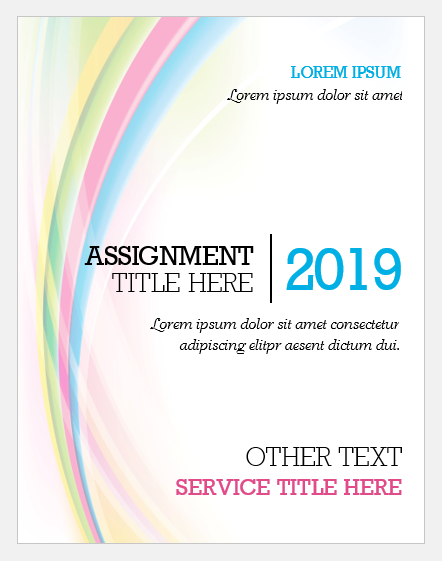
Assignment Cover Pages
Assignment cover page is the first page of an assignment. When you hold an assignment, the first page that you will see is the cover page. It is also called the title page. An assignment cover page includes the name of the institution, the title of the assignment, the name of the student and student’s ID. The assignment cover page is helpful in identifying what the assignment is about and which student submitted it.
Many students submit assignments to instructors, and instructors are usually teaching more than one subject. Therefore, without an assignment cover page, it would be difficult for the instructor to manage and sort out different assignments.
When there is an assignment cover page, instructors can easily sort out the assignments and grade them. Even the students submitting multiple assignments on the same day could end up submitting the wrong assignment if the assignments didn’t have a cover page.
Another important reason for having assignment cover pages is that this is part of training students to submit work professionally. An assignment cover page shows professionalism in submitting work. When students are trained for professional work, they are better equipped at succeeding in their jobs. Thus, professors and instructors usually ask students to create cover pages for their assignments so that the students develop this habit early in their academic life.
The assignment cover page usually includes the name of the institution, title of the assignment, name of the student, student id, date of submission. In some cases, the title page may also mention the instructor name. Usually, the title page is not page numbered.
Some courses might also require the students to format the assignment cover pages using popular referencing styles. For example, there is a particular format to make an assignment cover page using APA or MLA referencing styles. In some cases, professors may also issue detailed instructions on how to format an assignment cover page. These instructions may include font style, font size, text color, page borders, and the information that must be stated on the cover page along with a particular order.
Cover pages are required in several situations:
- When submitting a project report
- When submitting a research proposal
- When submitting a dissertation
- When making a report that is longer than 2-3 pages
- When the assignment instructions require an assignment cover page
- When the professor is handling more than one subject and assignments may be erroneously sorted
Assignment cover pages are very useful and can be created in MS Word or Adobe. MS Word software allows pictures and text to be used on the cover page. Students may also use headers and footers, page borders and other features in MS Word to create a nice cover page. You can even use the popular heading styles given in MS Word.
If you do not have the time or energy to create a cover page, you may use cover pages available on our website. We offer editable cover page templates that you can easily download and customize. Browse through our specially designed assignment cover pages and save your time and effort.

Assignment Front Page Format, Design, and PDF File
Today we are sharing the assignment first page format for schools and college students. This format very useful for students for their assignment submission in school, college and university. You can also download this assignment front page design in word file format.
Note: There is a no specific and pre-defined format for assignment cover page. The front page of assignment define by school, college, university, etc. But there is general format for assignment submission which is use globally. You can change or modified this format according to you.

1. Assignment Front Page Format
2. assignment cover page design.
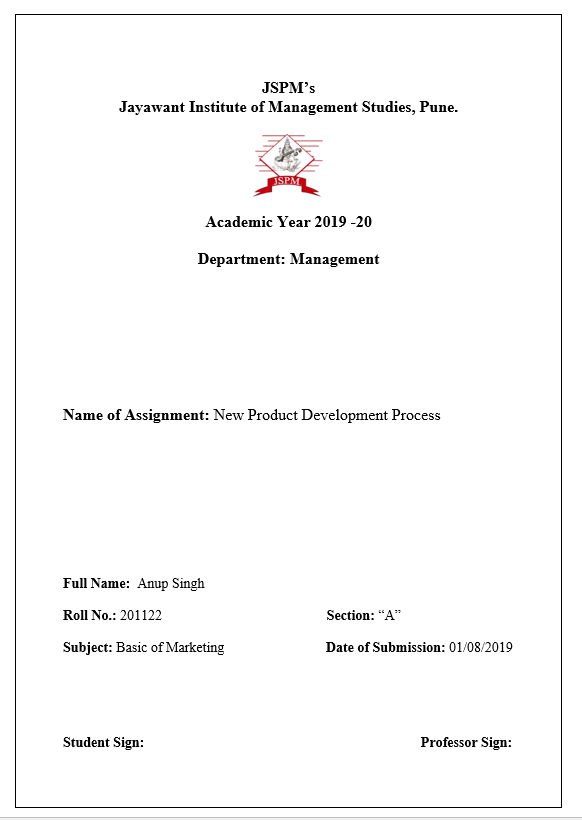
3. Download Assignment Design PDF & Word File
Here you can download the assignment front page format in word download. You can easily download assignment design file and edit it as per your need. You can also find this files in your Microsoft Office. Choose you best assignment front page design and impress your teachers or professors.
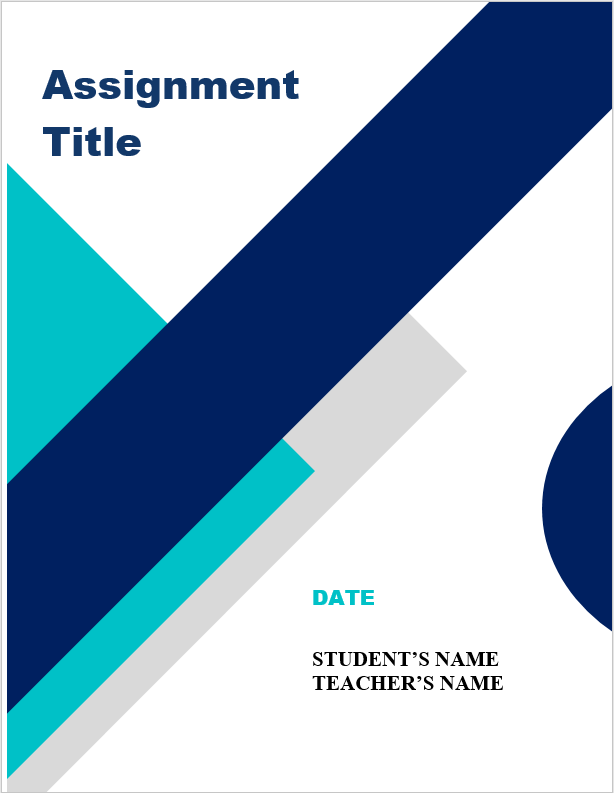
Source File & Credit: Microsoft Office
Use Microsoft Word to edit this file. You can easily edit this file in Microsoft Office. Replace the file with your college name, logo, etc.
Assignment is a very crucial part in academic. Your project report front page or assignment first page design play an important role like first impression is last impression. If you impress your processor or teacher then you will score good mark.
See More: General Topics for Presentation
Purdue Online Writing Lab Purdue OWL® College of Liberal Arts
MLA Works Cited Page: Basic Format

Welcome to the Purdue OWL
This page is brought to you by the OWL at Purdue University. When printing this page, you must include the entire legal notice.
Copyright ©1995-2018 by The Writing Lab & The OWL at Purdue and Purdue University. All rights reserved. This material may not be published, reproduced, broadcast, rewritten, or redistributed without permission. Use of this site constitutes acceptance of our terms and conditions of fair use.
According to MLA style, you must have a Works Cited page at the end of your research paper. All entries in the Works Cited page must correspond to the works cited in your main text.
Basic rules
- Begin your Works Cited page on a separate page at the end of your research paper. It should have the same one-inch margins and last name, page number header as the rest of your paper.
- Only the title should be centered. The citation entries themselves should be aligned with the left margin.
- Double space all citations, but do not skip spaces between entries.
- Indent the second and subsequent lines of citations by 0.5 inches to create a hanging indent.
- List page numbers of sources efficiently, when needed. If you refer to a journal article that appeared on pages 225 through 250, list the page numbers on your Works Cited page as pp. 225-50 (Note: MLA style dictates that you should omit the first sets of repeated digits. In our example, the digit in the hundreds place is repeated between 2 25 and 2 50, so you omit the 2 from 250 in the citation: pp. 225-50). If the excerpt spans multiple pages, use “pp.” Note that MLA style uses a hyphen in a span of pages.
- If only one page of a print source is used, mark it with the abbreviation “p.” before the page number (e.g., p. 157). If a span of pages is used, mark it with the abbreviation “pp.” before the page number (e.g., pp. 157-68).
- If you're citing an article or a publication that was originally issued in print form but that you retrieved from an online database, you should type the online database name in italics. You do not need to provide subscription information in addition to the database name.
- For online sources, you should include a location to show readers where you found the source. Many scholarly databases use a DOI (digital object identifier). Use a DOI in your citation if you can; otherwise use a URL. Delete “http://” from URLs. The DOI or URL is usually the last element in a citation and should be followed by a period.
- All works cited entries end with a period.
Additional basic rules new to MLA 2021
New to MLA 2021:
- Apps and databases should be cited only when they are containers of the particular works you are citing, such as when they are the platforms of publication of the works in their entirety, and not an intermediary that redirects your access to a source published somewhere else, such as another platform. For example, the Philosophy Books app should be cited as a container when you use one of its many works, since the app contains them in their entirety. However, a PDF article saved to the Dropbox app is published somewhere else, and so the app should not be cited as a container.
- If it is important that your readers know an author’s/person’s pseudonym, stage-name, or various other names, then you should generally cite the better-known form of author’s/person’s name. For example, since the author of Alice's Adventures in Wonderland is better-known by his pseudonym, cite Lewis Carroll opposed to Charles Dodgson (real name).
- For annotated bibliographies , annotations should be appended at the end of a source/entry with one-inch indentations from where the entry begins. Annotations may be written as concise phrases or complete sentences, generally not exceeding one paragraph in length.
Capitalization and punctuation
- Capitalize each word in the titles of articles, books, etc, but do not capitalize articles (the, an), prepositions, or conjunctions unless one is the first word of the title or subtitle: Gone with the Wind, The Art of War, There Is Nothing Left to Lose .
- Use italics (instead of underlining) for titles of larger works (books, magazines) and quotation marks for titles of shorter works (poems, articles)
Listing author names
Entries are listed alphabetically by the author's last name (or, for entire edited collections, editor names). Author names are written with the last name first, then the first name, and then the middle name or middle initial when needed:
Do not list titles (Dr., Sir, Saint, etc.) or degrees (PhD, MA, DDS, etc.) with names. A book listing an author named "John Bigbrain, PhD" appears simply as "Bigbrain, John." Do, however, include suffixes like "Jr." or "II." Putting it all together, a work by Dr. Martin Luther King, Jr. would be cited as "King, Martin Luther, Jr." Here the suffix following the first or middle name and a comma.
More than one work by an author
If you have cited more than one work by a particular author, order the entries alphabetically by title, and use three hyphens in place of the author's name for every entry after the first:
Burke, Kenneth. A Grammar of Motives . [...]
---. A Rhetoric of Motives . [...]
When an author or collection editor appears both as the sole author of a text and as the first author of a group, list solo-author entries first:
Heller, Steven, ed. The Education of an E-Designer .
Heller, Steven, and Karen Pomeroy. Design Literacy: Understanding Graphic Design.
Work with no known author
Alphabetize works with no known author by their title; use a shortened version of the title in the parenthetical citations in your paper. In this case, Boring Postcards USA has no known author:
Baudrillard, Jean. Simulacra and Simulations. [...]
Boring Postcards USA [...]
Burke, Kenneth. A Rhetoric of Motives . [...]
Work by an author using a pseudonym or stage-name
New to MLA 9th edition, there are now steps to take for citing works by an author or authors using a pseudonym, stage-name, or different name.
If the person you wish to cite is well-known, cite the better-known form of the name of the author. For example, since Lewis Carroll is not only a pseudonym of Charles Dodgson , but also the better-known form of the author’s name, cite the former name opposed to the latter.
If the real name of the author is less well-known than their pseudonym, cite the author’s pseudonym in square brackets following the citation of their real name: “Christie, Agatha [Mary Westmacott].”
Authors who published various works under many names may be cited under a single form of the author’s name. When the form of the name you wish to cite differs from that which appears on the author’s work, include the latter in square brackets following an italicized published as : “Irving, Washington [ published as Knickerbocker, Diedrich].”.
Another acceptable option, in cases where there are only two forms of the author’s name, is to cite both forms of the author’s names as separate entries along with cross-references in square brackets: “Eliot, George [ see also Evans, Mary Anne].”.
IGNOUHelp.in
A Leading Portal for IGNOU Students
IGNOU Assignment Front Page & Cover Page (PDF with Guide)
IGNOU Assignment Cover Page & Front Page Guide – Before writing and preparing your assignments, candidates who belong to any academic program of IGNOU have to read every point of assignments carefully which is given in the section. It is necessary for candidates to follow each point so that their assignments can be approved without any issues and you will get a reward for your hard work on the IGNOU Grade Card .
It is mandatory for IGNOU students to attach the assignment front page before each assignment solution that will help the evaluator to get to know about your program, subject, and other important information of student. Failing to do so may be subject to the cancellation of the submitted assignment or non-updation of status and marks online.
You Can Also Read:
- IGNOU Assignment Last Date June & Dec 2024
- IGNOU Assignment 2024 (June)
- IGNOU Solved Assignment 2024
- IGNOU Assignment Status 2024 (UPDATED)
IGNOU Assignment Front Page & Cover Page
Every student has a query that what are the things they have to write on the IGNOU Assignment Front Page or Cover Page which they have to submit to the concerned study centre of IGNOU. It is compulsory to make the front page of each subject’s assignment so that evaluators can easily understand and know about the details of the submitted assignment.
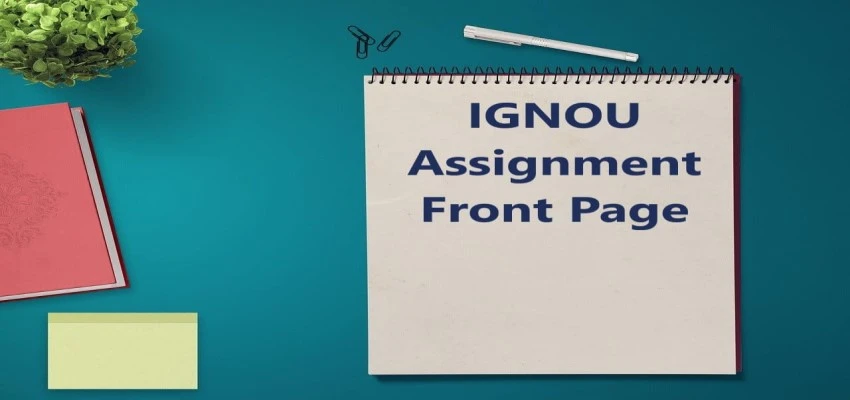
The front page also makes it easier for evaluators to make the process faster of the evaluation. Candidates have to submit their assignments only to the coordinator of their study centre only or in some cases it can be submitted to the regional centre as well.
How to Make IGNOU Assignment Front Page?
At the time of writing your assignments or after completion of assignments, candidates are confused that what to write on the first page of their IGNOU Assignment so here is a solution to all your queries. We have made a list of all required details and information to be written on the cover page of your assignment solution. Each and every detail is given in the following list is compulsory to write on the page.
- Programme Full Name
- Course Code
- Course Title
- Assignment Code
- Study Centre
- Session Month & Year
- Mobile Number
- Enrollment Number
- Student Name
- Residence Address
Demo Image for the IGNOU Assignment Front Page
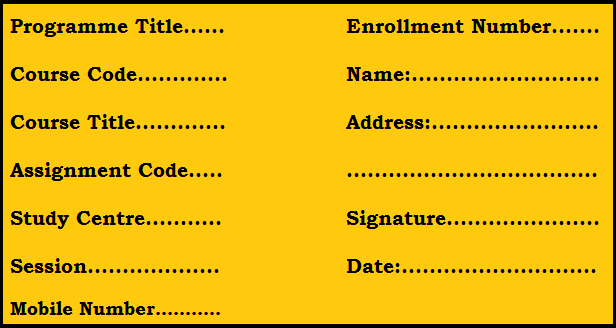
IGNOU Assignment Front Page PDF
If you want to download the readymade print format of the IGNOU Assignment Cover page then you can download the same from the given link. You just need to take a printout using a printer and write all the required information on it before submission of the IGNOU Assignment.

Click To Download IGNOU Assignment Front Page PDF
You have to attach this PDF file while submitting your online assignment to IGNOU and keep in mind that you have to do the same for all your subjects.
IGNOU Assignment Front Page Filled
If you want to know How to Fill IGNOU Assignment Front Page then we have attached a filled IGNOU Assignment Front Page that will help you to fill your front page. Furthermore, it will help you to know how it should should like after filling.
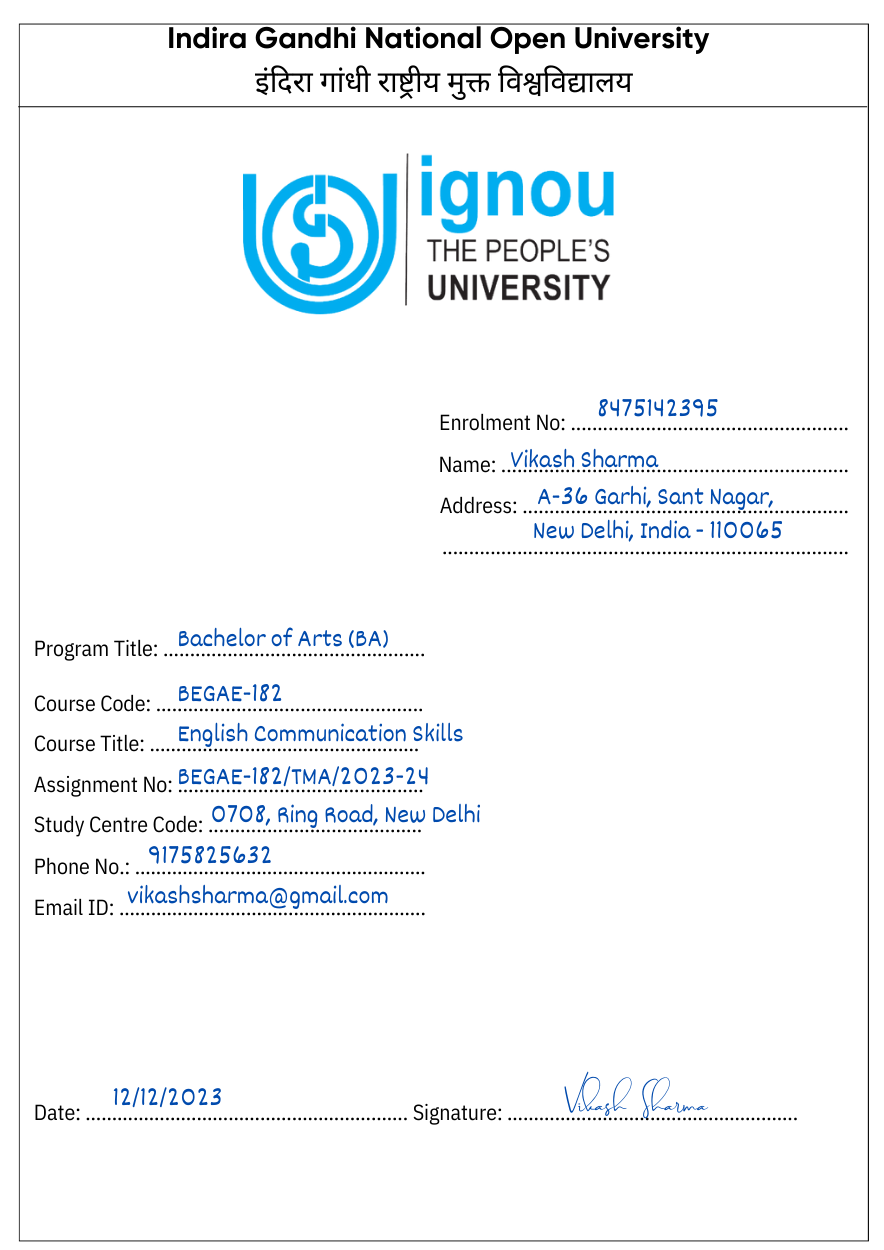
Step by Step Instructions to Prepare IGNOU Assignment
Candidates are requested to read each point carefully to prevent from making mistakes while writing the assignment of IGNOU. We have created the instructions point wise so that you can read and understand them easily.
Point-1: Use only foolscap size paper or A4 size paper to write your assignments. Do not use thin paper.
Point-2: Leave at least one or a few lines after completing your one answer so that the evaluator writes a useful comment on blank areas.
Point-3: We recommend using ruled paper instead of blank paper to write your assignment because it is also advised by the IGNOU Officials .
Point-4: Candidates can use a Black or Blue pen to write their assignments for any TEE session.
Point-5: Candidates are not allowed to use the Red pen or other colour pen.
Point-6: Better handwriting also benefits for best marking in your assignment work.
Point-7: Candidates have to write their assignments with their hand which means only handwritten assignments are accepted by IGNOU.
Point-8: Do not print or type your assignments with the help of a computer which is not allowed.
Point-9: They cannot copy their answer from any units/blocks given by the university. If you copied any answer then you will get zero marks for that copied question.
Point-10: Candidates have to write an assignment solution with their own help, if you copied any assignments from other students then your assignment will be rejected by the centre.
Point-11: Prepare or write each course assignment separately. Do not write all assignments in one set.
Point-12: Write each question before writing an answer so you don’t need to attach a question paper while submitting the assignment.
Point-13: After finishing the work of assignment writing, use a paper file and arrange all your assignments in a proper manner. ( Note: Plastic files will not be accepted by the university in any circumstances).
Point-14: Candidate must be sent their complete assignments to the coordinator of the allotted study centre. You cannot send it to any other IGNOU centre like Regional Centre, Evaluation Division, and Registration for evaluation.
Also Read: How To Submit IGNOU Assignment Online?
Point-15: It is noted that the candidates have to submit their assignment personally so you can’t send it through email, post or courier.
- IGNOU Regional Centre List
- IGNOU Study Centre List
Point-16: Don’t forget to receive the receipt for the submission of the assignment.
Point-17: After submitting your assignments to the coordinator, they send an acknowledgement to the study centre.
Point-18: If you have applied to change your study centre then you have to send your assignments to the original centre until you did not get any confirmation from the University of the study centre change. If you got a notice from the university for a successful change of centre then you can submit it to the new centre.
That’s It.
We hope that the above points will be helpful for those students who are confused or have no idea that what to write on the 1st page and what instructions needed to follow to successfully submit the assignments to IGNOU. We are sure that you got your solution from here after reading this article.
We request to all our candidates that please read and refer to every point given above and send your proper IGNOU Assignment solution so that it easily accepted and approved by the university and you can get a permit to appear in your TEE Examination.
Without writing assignments and submissions, no candidates will be permitted to attend any of the examinations conducted by IGNOU. Even students are not eligible to fill their IGNOU Exam Form of any session if they failed to submit their required assignments to the university before the last date of the submission deadline.
IGNOU Assignment Front Page: FAQs
Q1. Is the IGNOU Assignment Front Page Compulsory? Answer: Yes, It is mandatory for submitting the assignment.
Q2. Are Typed or Printed Assignments Accepted? Answer: Unfortunately, no. Typed or printed assignments are not considered valid.
Q3. Do I Have to Create a Cover Page for Each Assignment? Answer: Yes, it’s mandatory to include a front page for every assignment in every subject.
Q4. Should I Submit Separate Files or Sheets for Each Subject? Answer: Yes, submitting separate files or sheets for each subject simplifies evaluation.
Q5. What Type of Paper or Sheet Should I Use? Answer: Candidates are advised to use A4 size ruled sheets.
Related Posts:
- IGNOU Solved Assignment 2023-2024
- IGNOU Assignment Submission Last Date 2024 (Re-Extended)
- IGNOU Project 2024: Submission Last Date, Status,…
- IGNOU Assignment Status, Marks & Result 2024 (UPDATED)
- IGNOU Passing Marks Out of 100, 70, 50 for Exam…
- IGNOU Percentage Calculator 2023 (December)
349 thoughts on “IGNOU Assignment Front Page & Cover Page (PDF with Guide)”
cover page black and white will do or not to submit assignment?
Can anyone tell me ,, can I submit my report proposal synopsis in typed form .. or I have to write it by my hand ??reply asap
where are the assignments questions ?
Do we need to use any A4 size single ruled paper mentioned for assignments or the one above shown with the ignou logo on ? if yes where can we get that ?
BSWG I am yet to receive the Assignment paper 121 122 123 from my center At Vidyasagar College for Women IGNOU SSC-2827D at Vidyasagar Smriti Mandir, 36, Vidyasagar Street, Kolkata – 700009 for BSWG. I do not know whether assignment paper released by the IGNOU are valid or not. Moreover I have not found nowhere English in Daily Life, Assignment paper 135. I would feel obliged if I get the proper advise from your end as early as possible as the date of submission is 31/3/2024. Yours, etc Ujani Som Enrolment Number 2351686811 BSWG Bachelor of Social Work RC Code 28:Kolkata
what is word limits in 5 marks questions in assignment?
Anybody here doing BBA july 2023 session, drop your mail or contact, let’s connect.
here anyone doing mec course when is the last date for submission and can we use sketch pens for headlines
here any one doing BBA course for July 2023 session.
can we use sketch pens…for headlines
Hi i have done my assignments on blank paper but is written recommend ruled paper not mandatory ruled paper. Will it not be acceptable.
last date of submission?
I think it will be extended beyond 30th april
Written Both side of A4 size page is acceptable?
Hi, I have registered for PGDCA_NEW for Jan 2023 session. Can I submit my assignments online?
It depend upon your Regional Centre, there’s list published by IGNOU which shows whether you have to submit online or offline for your particular RC
when will the exam of bapch 2023 jaunary session?
At the end of the year, maybe in December. I’m also student of January 2023 session BAHIH
last date of assignments submission for june 2022 admission batch …plzz tell?
I am a PG Diploma student (June 2022 batch). We need to submit assignments only for those papers for which we will give exam in that year. If I submit assignments for 3 papers and give exam only for 2 out of those 3 papers, do I need to resubmit the fresh assignment for the remaining paper next year or will the marks be carried forward?
can use double side rulled sheet
Can I use A4 size paper(unruled) for assignments? And do I have to make my assignments separately for each paper? Please let me know about this matter and the assignments submission last date for June TEE 2023????
June TEE 2023 assignment submission last date 31st March
December tee exam when it will be declared i got updated marks with 1 subject only renaming 3 are left to update it
I have to submit my assignment for 1st semester exam in October and i failed to submit and not attended the exams either whether I am able submit sem1 assignment along with sem2 assignments session.
can i use both side of the page for answer ?
Which kind of file do we need to put the assignment in there for submission? Do we need different files for different assignments? Or we can put it together ?
Different files for Different Assignments
can assignments be submitted by our relatives?
I think yes
I’m pursuing CRUL 2022. I registered in July 2022 for this. So what’s the last date of submitting Assignment date? and When the exam will be conducted?
july 2023 session m June m re-registration kr lia h maine. assignment bnane start kr skti hu ab Mai.. last date submit ki kb h
sir i need pgddm course solved assignment
Hlo sir Hindi medium se admission liye the 2nd year mein hun ab Assignment English mein likh sakte hain🤔
Sir I didn’t get assignments marks of 2 subjects till now. I have complaint regarding my assignments many times to study centre but I haven’t got any response from them. Now what to do if any suggestions are there let me know.
Hi any body who are taken admission in BSLIC can share few information regarding programme.
If I don’t write my basic information like name, enrollment no, address, course code and other on the front page and evolution but type these all, will it be ok or any problem???
sir Namaste! We are kindly request to you please Announce B.A.E.G.H Course June session 1st Year T.E.E Exam in 2020-2021 year ( Exempted papers due to corona panda mic) Results and 2nd year T.E.E. Exam in 2021-2022 June session ( 10 papers) Results as early as possible! Thank you very much to IGNOU Authorities for your support and encouragement of I.G.N.O.U Students.
Please upload ACC01 assignment
hi. i took admission on July 21. i missed 22. if I want to sit 23 July then should I have to re register? if yes then how ? and then which session assignment i have to submit?
Sir when my assignment will take place….I had taken admission in BAG programme in july2022… And how I get notifications about all IGNOU updates on my phone
You need to visit IGNOU Official Website to see all the necessary events. You can follow the official IGNOU account on Instagram and Twitter. Check out student portal, there search for assignments, you’ll find your assignments’ questions.
Complete your assignments and submit online and offline in both modes before 30th November, 2022.
how to submit practical assigment MCA_NEW PROGRAM is it written or not??
Mso ka v practical hota hai kya
Do, we take 1st page/ student information page from computer print orelse we need to Pen them down?
Take print out of the front page and get the Xerox copy according to the number of your assignments. And then fill them up.
we have to download front page online and have to put details in it
In MCA assignment of Professional Skills and Ethics in Q4. it’s said to make a ppt So when do we have to submit the ppt? for july session 22′
Hey Sanjana, I have just joined MCA from IGNOU. Can you just help me with your experience ?
mos first year course title
I’m studying for BCAOL. So how do I send my assignments online?
Hey bro! I’m also pursuing BCAOL from IGNOU. You want to connect?
Can you please let me know how u submitted ur assignment online, do we have any links?
hey kaushal i am also take admission for same stream i want to connect with you
Leave a Reply Cancel reply
Your email address will not be published. Required fields are marked *

Download IGNOU Assignment Front Page 2024 (PDF With Filling Guide)
- April 8, 2024
Hii Students, if You Are Looking for an IGNOU Assignment front page a4 size pdf or IGNOU cover page pdf, then you have come to the right palace. We are going to share five types of first-page pdf here you can download anyone by your choice. In This post we will also tell you how to fill course details in the given field. And if you want to prepare the front page by yourself, we will discuss how to do it with pen and paper.
5 Types of IGNOU Assignment Front Page a4 Size pdf Download Any One
1. Here is the 1st cover page pdf file with all the required details, which should be on IGNOU assignment cover page. simply click on it to download.

DOWNLOAD NOW
2. Here is the 2nd PDF file, which has two extra fields one is an address(Student address), and the other is an email address. These are not required fields. You can skip them. If you still want to fill in these details also, then download below pdf.

Related Post:
- How To Submit IGNOU Assignment(Online And Offline Process)
- How To Write IGNOU Assignment to get Best Score 2024
- IGNOU Date Sheet For June 2024 Exams
- IGNOU Assignment Submission Links
3. Here is the 3rd pdf file. It has a different style. You can also download it. Check out the below pdf.

4. Here is the 4th pdf file. It has different styles with big fonts. You can also download this one if you need additional and oversized fonts.

5. Here is the 5th assignment cover page pdf for Hindi Medium Students .

6. Here is the 6th assignment cover page pdf for Hindi Medium Students .
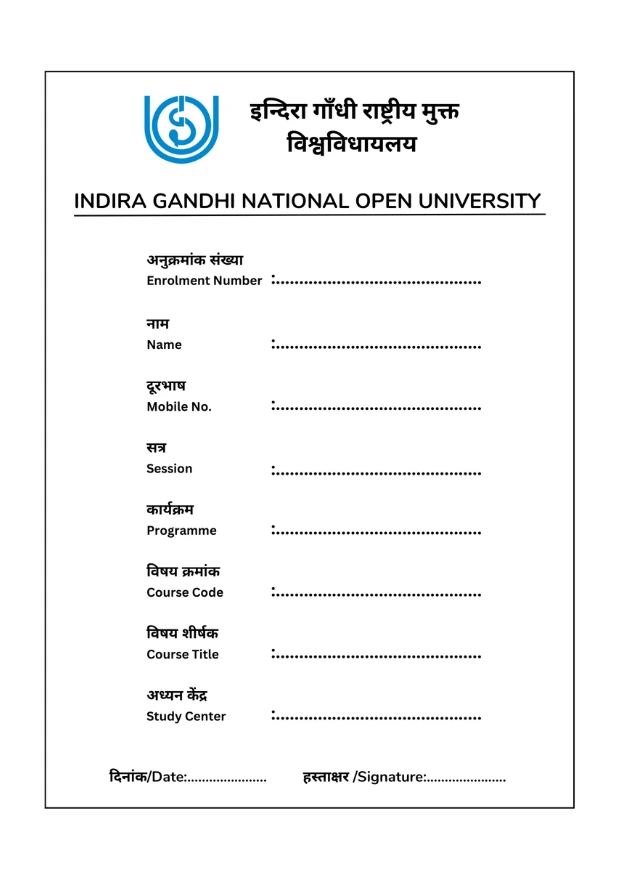
Our Recommendation :- You can use any pdf from the above, all are having required details which should be on the cover pages, but we recommend you use the first one that is not having extra fields. and if you want to make a First page by your-self by pen-paper then let’s start how to do that.
How to Make IGNOU Handwritten Assignment Front Page
If you don’t want to print the front page, you can prepare it yourself. It is not compulsory to print out the pdf. You can make it by yourself and submit it, but remember there must be all details fulfilled related to the students and programme so the teacher can identify the particular student correctly. For your convenience, here is a format of handwritten IGNOU assignment front page ; check below image .

- How To Write IGNOU Assignment To get Good Marks
- IGNOU Date Sheet For December 2024 Exams
- Download IGNOU Old Papers Eaisly
How To Fill IGNOU Assignment Cover Page Details Step By Step Guide 2024?
When you start writing your assignment, the first thing you need to do is to complete the First page. This includes all the essential information about Student and Programme. The following details are mandatory on the ignou assignment front page: fill them in carefully.
- Programme Code (It is the code In which you took the Admission, e.g. BAG, BCA, MEG, MCA, MBA etc.)
- Course Code (Subject Code, Every Programme has multiple Course Codes in a session like BCS-12, BEGLA-136, MCO-01 etc.)
- Course Title (Every Course has a Title Like Hindi Sahitya, English in Daily Life, etc.)
- Assignment Number/Assignment Code/Session (you will get this code on IGNOU Assignment Question paper)
- Study Center Code (You Will get Study Center Code on IGNOU Identity Card)
- Student Name (Student name as IGNOU ID Card)
- Enrollment Number (You Will Find Enrollment Number on Student ID Card)
- Phone Number (Student Phone Number)
- Submission Date (Assignment Submission date)
- Signature (Student Signature)
Check the Below image. For your convenience, we have filled in the details on an assignment page. You can follow this sample image to fill up your details.
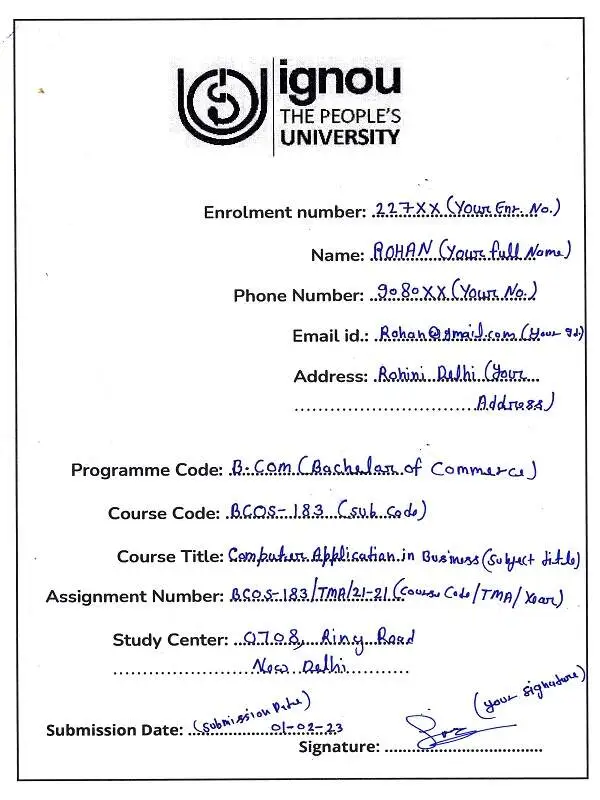
What is Assignment Number ?
The assignment number and assignment code both are the same things on the IGNOU assignment cover page. This helps the teacher to identify which session the student belongs to and for which session exams the student submitted the assignment. For example, if your course code is BCOS-183 and you are having your exams in June/Dec 2024, then your assignment number/assignment code will be like this BCOS-183/TMA/23-24 , where TMA Stands for Tutor Marked Assignments. You will find the assignment number on your IGNOU assignment question paper , as seen in the image below.

What is Session ?
You will get only one field from these three on the first page of IGNOU Assignments: Assignment number, Assignment Code, or Session. These all describe the same thing: that is the student session he belongs to, so if you have asked session on the front page, fill in your current session, you will get your session in your IGNOU Registration Portal .
Thank You. Dear Students To Visit our Website. If You Still Have Any Query Related To Assignment Front Page, You Can Comment Below. We Will Surly Help You.
60 thoughts on “Download IGNOU Assignment Front Page 2024 (PDF With Filling Guide)”
what is the last date of MCA_NEW January-2024 assignment submission ?
30th April 2024
Leave a Comment Cancel reply
Save my name, email, and website in this browser for the next time I comment.
All Courses PrevIous Papers
Download old papers (all courses), bca old papers, bag old papers, bcomg old papers, mca old papers, mba old papers, meg old papers, ignou query, download front page, ignou helpline details, check assignment status, how to submit assignments, download assignment papers, assignments submission link, how to write ignou assignments.
- Administering Payroll for the United Arab Emirates
Payroll Relationship and Termination Dates
When you terminate an employee or end an assignment record, the Payroll Relationship page displays the corresponding dates. These dates control how earnings and deductions are processed for the terminated employment record.
For example, David Ellis resigned from his teaching post at Royal High School, and his line manager enters a termination date of 22-July-2020. The application will process David's last payroll payment for 31-July-2020. You can view these termination dates on the payroll relationship page for David. These dates show up at all the employment levels of David, such as assignment, associated payroll, and payroll relationship.
This image shows David's Ellis payroll processing dates and the behavior of the application for handling the payroll records:

Terminate and Delete Payroll
You can terminate or delete a payroll association from the Payroll Association region. Select Edit and then click on Delete to choose between Delete Payroll Association or Terminate Payroll.
When you terminate a payroll association, the worker's payroll association is terminated with the Last Standard Earnings Date as the termination date. The Last Standard Process Date defaults to the end of the pay period but the Final Close Date is left blank.
In cases where you have to delete the payroll assigned to an employee, you can choose Delete Payroll Association from the Payroll Association region. The payroll association and records are deleted and no record of the payroll association remains.
Reverse Terminate Payroll Association
For employees with a terminated payroll association, you can select the Reverse Terminate Association option to reactivate the payroll association. The reactivated payroll association becomes the primary payroll associated with the employee and the corresponding element entries and calculation cards are reactivated.
Related Topics
- How to Set End Dates for Terminations
- How Terminations Affect Payroll Processing

IMAGES
VIDEO
COMMENTS
Assignment due date. Page number 1 in the top right corner of the page header. The format for the byline depends on whether the paper has one author, two authors, or three or more authors. When the paper has one author, write the name on its own line (e.g., Jasmine C. Hernandez).
Title Page Content. student title page includes the following elements: title of the paper. author(s) ° include the full names of all authors of the paper; use the form first name, middle initial, last name (e.g., Betsy R. Klein) ° if two authors, separate with the word "and". (e.g., Ainsley E. Baum and Lucy K. Reid)
In this video, we're going to show you the steps on how to format your university assignment/ report on Microsoft Word. In this example, we have a dissertati...
The student version of the APA title page should include the following information (double spaced and centered): Paper title. Author name. Department and university name. Course number and name. Instructor name. Due date of the assignment. The professional title page also includes an author note (flushed left), but not a course name, instructor ...
1. Student's Name: Begin with the first student's name on the top-left corner of the page, double-spaced. 2. Additional Authors: If there are more authors, list each on a separate line following the first student's name. 3. Instructor's Name: Below the last author's name, including the instructor's title, like "Professor Willow," on a new line.
Title page. Most assessments need a title page, which should include: the title and number of the assessment; the course number and name; the due date; your full name and student number. Centre this information on the page, starting approximately one-third of the way down the page. Numbering. Number and clearly label figures and tables.
Create online Cover Pages for printing. You can enter our free graphic editor from your phone, tablet or computer. The process is 100% online, fun and intuitive. Just click on what you want to modify. Customize your cover page quickly and easily. You don't need any design skills.
On the last line is the assignment due date, ex: February 29, 2028; Abstract. If you are asked to prepare an abstract for your research paper, click Insert/Page Break to get to the top of a new page, and center the word Abstract in bold on the first line. Abstracts are typically no more than 250 words.
Assignment due date. Provide the due date for the assignment. Center the due date on the next double-spaced line after the instructor name. Use the date format commonly used in your country. October 18, 2020 18 October 2020. Page number. Use the page number 1 on the title page.
04. Create graphs and charts people want to look at. Graphs and charts tend to draw someone's eye. If you see a page full of text, or a presentation full of bullet points, these picture representations of your work tend to be where people look first. Sometimes, they even set the tone for what someone is about to read.
What this handout is about. The first step in any successful college writing venture is reading the assignment. While this sounds like a simple task, it can be a tough one. This handout will help you unravel your assignment and begin to craft an effective response. Much of the following advice will involve translating typical assignment terms ...
Courses and assignments should be planned with this in mind. Three principles are paramount: 1. Name what you want and imagine students doing it. However free students are to range and explore in a paper, the general kind of paper you're inviting has common components, operations, and criteria of success, and you should make these explicit ...
Download Free Cover Page Templates. Explore our collection of 23 beautifully designed cover page templates in Microsoft Word format. These templates feature captivating colors and layouts that are sure to make a lasting impression. Simply click on the preview image of each template and download it for free.
Your document must have 1" (one inch) page margins on the top, sides, and bottom of the document. How to Check the Page Margin Size. Click the "Layout" tab (A) in Microsoft Word, and click the "Margins" drop-down arrow (B). Click on the "Normal (2.54 cm)" margin selection (C), as pictured in Figure 2. Figure 2 - How to Check the ...
Conclusion should not be longer than 10% from the word count. If a paper has 900 words, conclude it in 90. If there are 3000 words, then compose about 300. This will create great harmony, preventing your readers from feeling bored or overloaded. Present summary but don't copy previous sentences.
Assignment cover pages are very useful and can be created in MS Word or Adobe. MS Word software allows pictures and text to be used on the cover page. Students may also use headers and footers, page borders and other features in MS Word to create a nice cover page. You can even use the popular heading styles given in MS Word.
Assignment is a very crucial part in academic. Your project report front page or assignment first page design play an important role like first impression is last impression. If you impress your processor or teacher then you will score good mark.
If you refer to a journal article that appeared on pages 225 through 250, list the page numbers on your Works Cited page as pp. 225-50 (Note: MLA style dictates that you should omit the first sets of repeated digits. In our example, the digit in the hundreds place is repeated between 2 25 and 2 50, so you omit the 2 from 250 in the citation: pp ...
On the APA reference page, you list all the sources that you've cited in your paper. The list starts on a new page right after the body text. Follow these instructions to set up your APA reference page: Place the section label "References" in bold at the top of the page (centered). Order the references alphabetically. Double-space all text.
IGNOU Assignment Cover Page & Front Page Guide - Before writing and preparing your assignments, candidates who belong to any academic program of IGNOU have to read every point of assignments carefully which is given in the section. ... IGNOU Assignment Last Date June & Dec 2024; IGNOU Assignment 2024 (June) IGNOU Solved Assignment 2024; IGNOU ...
Google Assignments (LTI 1.3) is the way to create an assignment based on a resource in Google Drive. You can use the Google integration to create an online assignment that embeds a document directly from your Google Drive folder. Google Assignments (LTI 1.3) supports file types including Documents, Sheets, Slides, and Drawings. May 22, 2024.
The following details are mandatory on the ignou assignment front page: fill them in carefully. Programme Code(It is the code In which you took the Admission, e.g. BAG, BCA, MEG, ... what is the last date of MCA_NEW January-2024 assignment submission ? Reply. IGNOUBABA. March 19, 2024 at 10:46 pm 30th April 2024. Reply. Comment navigation.
The application will process David's last payroll payment for 31-July-2020. You can view these termination dates on the payroll relationship page for David. These dates show up at all the employment levels of David, such as assignment, associated payroll, and payroll relationship. This image shows David's Ellis payroll processing dates and the ...
A new tool called Writable, which uses ChatGPT to help grade student writing assignments, is being offered widely to teachers in grades 3-12.. Why it matters: Teachers have quietly used ChatGPT to grade papers since it first came out — but now schools are sanctioning and encouraging its use. Driving the news: Writable, which is billed as a time-saving tool for teachers, was purchased last ...